




Aditi’s family wanted to know the Navy was a smart career choice. Now Aditi’s joined they’ve discovered her Navy engineering education and training is also recognised by many industries outside of the Australian Defence Force.

But that wasn’t the only thing they found out. In fact, the Navy is supportive of all backgrounds, cultures and beliefs.
Aditi works in one of many diverse roles, with great career advancement opportunities, offering her a rewarding career as a Marine Engineer Officer that makes her family proud.
Find out for yourself. Watch Aditi and Priya’s full story. defencejobs.gov.au/family
As you get towards the end of your 40s, life usually begins to ‘settle’ if you are lucky. Your career is consolidating; you’ve passed on your gene pool, and you’ve formed social relationships that are stable and rewarding.
And just as you start to think life may even be rosy, it starts to take an interesting turn.

You find yourself in the sandwich.
On the one side, you have kids flowering into adulthood, causing your relationship with them to change from authoritative to co-operative, bringing with it the fear of letting go. On the other, you have parents wilting into the sunset of their lives, causing your relationship to change from co-operative to supportive, bringing with it, again, the fear of letting go but in a more permanent sense.
In our own community here in Australia, many of us have family
relationships split across two continents: one, with seniors back in India, and two, with their young families here in Australia. (This, of course, excludes those that now have their elderly parents living with them here.)

Those with split families in two continents, experience the tyranny of distance. The advantage, often, is the strong network of social support that India offers. There are solid community and family bonds that facilitate access and availability of assistance for the elders in the family. The challenge for the middle generation is to manage time, so as to be able to spend large periods with the elderly parents.
The advantage in the Australian system is that employment can offer you breaks and with longevity in a company, there are options of long service leave, etc., which can be availed. However at that stage of your professional lives, job responsibilities are such that it may be difficult to have extended breaks. While professionally, there may be an option to manage the situation, another challenge arises from the next generation. Specific challenges can be faced such as in case it is an HSC year and the parent needs to be overseas on family duty.


Of course, the pressures are different if the three generations are together in Australia. While there is no need for travel, there is limited social support, and so there are demands on time to care for the parents.
In either case, there is no simple solution as the squeeze is felt; rather, the challenge is how to manage these responsibilities.

Sandwichers should consider this a stage of development with its own particular challenges. Recognise that there is no right way, and your unique circumstances will require you to tailor your own solutions to suit. Perhaps you can prepare yourself by developing, over the years, relationships with both generations that are nurturing and honest. There’s a lesson there for younger readers not yet feeling the squeeze.
And for those in the thick of things right now, a reminder: take time out to look after your own selves as you look after others. Ensure you have healthy eating and sleeping patterns. Adopt a flexible approach as you plan your daily schedules.
Treasure every moment with your loved ones.
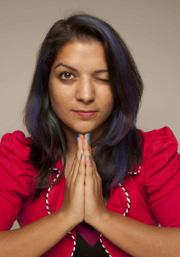
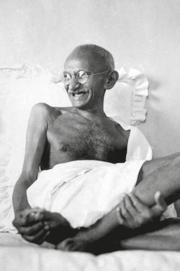

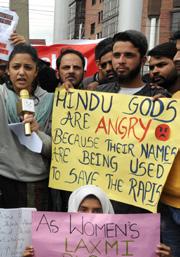






By replacing and upgrading parts of the existing phone and internet network, nbn is bringing more Australians access to fast and reliable broadband services.*





Most homes and businesses need
As most existing landline phone and internet services will be disconnected, it’s important you switch a ected services before your disconnection date.^ nbn will notify you by mail once you can switch to a new plan over the nbn™ access network. You’ll then have up to 18 months before existing services are disconnected.^




nbn is a wholesaler








This means nbn does not sell to the public. nbn supplies phone and internet providers with wholesale services they combine with their own
network services to deliver your new plan. So you’ll need to contact your preferred provider once you’re ready to switch.
Factors a ecting



The nbn™ access network and your provider’s network are likely to slow down when more people are online at once (particularly during typical busy periods, like evenings). Maximum speeds will also vary based on your modem, Wi-Fi and other issues.* For more information on how your particular experience will be a ected, speak to your provider.
Safety-critical devices like medical alarms, fi re alarms, monitored security alarms and lift emergency phones, may not be compatible with your new plan at all times.† To help minimise a loss in your services, check with your device provider that these will work on your new plan or whether you’ll need to fi nd an alternative solution. It’s also important you register safety-critical devices with nbn by calling 1800 227 300 or visiting nbn.com.au/compatibility.



*Your experience, including the speeds actually achieved over the nbn™ broadband access network, depends on the technology over which services are delivered to your premises and some factors outside our control (like your equipment quality, software, signal quality, broadband plan and how your service provider designs its network). nbn is a provider of wholesale speeds to internet providers. nbn™ wholesale speed tiers available to your phone and internet provider vary depending on the access technology in your area. ^ Services o ered to phone and internet providers over the nbn™ broadband access network will be replacing phone and internet services provided over most of the existing landline networks, including copper and the majority of HFC networks within the fixed line footprint. Services provided over existing fibre networks (including in-building, health and education networks) and some special and business services may not be a ected. To find out if your services will be a ected, please contact your current phone or internet provider. For more information, visit nbn.com.au/ switcho or call 1800 687 626.† The rollout of the nbn™ broadband access network will involve new technologies, and some existing devices (including many medical alarms, autodiallers and emergency call buttons) may not be compatible with these at all times. You should contact your device provider to find out if your alarm or other device will work when connected to the nbn™ broadband access network and what alternative solutions are available. For more information, visit nbn.com.au/compatibility.
© 2018 nbn co ltd. ‘nbn’, ‘bring it on’, ‘Sky Muster’, ‘gen nbn’ and the Aurora device are trade marks of nbn co ltd | ABN 86 136 533 741.







We shared Mary Kom’s incredible maiden CWG win in boxing Chandra Kishore wrote: Congratulations lady! Next movie “Mary Kom strikes back”.
NANDHITA SURESH wrote about Shweta Bhargava’s painting

Bani Thani that made it to the Royal Easter Show
Dinesh Sharma wrote: Good job, Shweta. There is a dearth of Indian artists in Australia, and those who exist have either adapted to European or abstract art forms, or given up practising art by taking up part-time jobs. Australian-Indian community should do more to promote such artists and their artwork, so that the essence of Indian art form in Australia is alive and our children, who are growing up here, are aware of such wonderful storytelling art forms, its history, and ther craftsmanship behind them. I wish you all the best. Ashish Bhargava wrote: Awesome artwork, loved it.
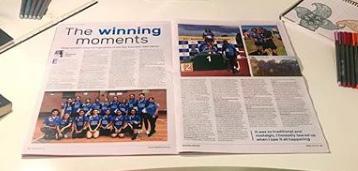
INDIAN LINK tweeted about Vinesh Phogat’s gold win in freestyle wrestling. Col Irwin (Aussie Wrestler) wrote: Ironically I just watched Dangal the other day…

We shared the CWG medal tally in which India stands at the third spot. Deepika Bharti wrote: I hope our government, non-government agencies and communities start putting resources into sports from the beginning itself. So proud of everyone.
Roopa Mrudul wrote: Proud of both India and Australia

This time’s entry is from @ lmergirl: So I’ve gone from reading the paper when I was a kid, to helping write a piece for it (on the Sikh Games no less). Living in a whole new reality #indianlink
Post a picture on Instagram of Indian Link at home, work or anywhere else in your life, using the hashtag #indianlink. We’ll select the best one and publish it here.






Would you pay to protect your personal data on social media?
Yes: 75% No: 19% Maybe: 6%
Our Facebook post about an Indian grandmother’s hellish journey received a record number of responses, mostly sympathetic.

Vani Shukla wrote: Sorry for poor grandmother…but it was de nitely a mistake.


Pawan Kumar wrote: If someone is carrying a bomb, they won’t write so on their luggage. Security of cials were being really silly.
RAJNI MADAN interviewed Alan Posselt about how he fell in love with the Indian instrument.

Deen Parast wrote: It is indeed very sad that Indians are losing interest in their own classical music.
Meet my new friends!! Met them at the @ ballaratwildlifepark near Melbourne. I think he liked my hat!

Parineeti Chopra on her visit to Melbourne
So con icted! Who to cheer for? A fellow Sidhu or a fellow Australian? Glad I can now congratulate both. Well done!!#GC2018
Harinder Sidhu, Australian High Commissioner to India, on CWG 2018 shooting event
SAGAR MEHROTRA asked on Indian Link Radio: Have you forgiven Steve Smith in your books?

Ashok Pillai wrote: I strongly think that Smith and Warner will appeal against the sentence and it will be shortened. My guess is that Smith will return in less than 6 months even though the captaincy ban of 2 years will remain intact
Rachit Mehta wrote: Whatever u do on- eld/off- eld should be within the laws of cricket.



Sonali Shah Thakkar wrote: Galti ki hai toh bhugatni padegi (Do the crime, do the time). Their lives might not be the same again. They might be good men but they have to pay for the “lapse of judgement”. They are role models for many and having no penalty to face would have set a precedent that it’s ok to cheat. We all want to teach our kids to be honest and these role models need to teach the same. The public won’t spare anyone who does anything wrong and that’s what you have to contend with in the senior positions. Yes, their ‘crime’ may not be as severe as match- xing but still, cheating to win, done in all good intentions, is not acceptable. Azharuddin and Hanse Cronje were both great players and excellent captains but aaj bhi jab unka naam aata hai (today when their names are uttered) the rst thing we think of, is match- xers.
Ajay Punj wrote: This is not new. Sledging etc has gone on for long in the name of mind games. They have shamed themselves, their country and the game of cricket. Test cricket is played these days in such a way that you have to win at any cost, fair or unfair. Was the public meltdown coached by the handlers/media advisors? Poor Bancroft, I feel for him. He did as instructed by his seniors. But what he did was unpardonable.
Shivdev Kler wrote: High praise for this young cricketer. We are all human, we all make mistakes. Smith deserves our forgiveness.
Sagar Mehrotra concluded: This incident is not going to fade away from our memory that easy, as you mentioned with the example of Azhar or Sreesanth or Cronje. I say this is just the tip of the iceberg: the culture that Australian cricket nurtures is far from fair go.
Writer Roanna Gonsalves has been shortlisted in the NSW Premier’s Literary Awards for 2018 for her book The Permanent Resident. Pearl Fernandes wrote: Congratulations Roanna Gonsalves!
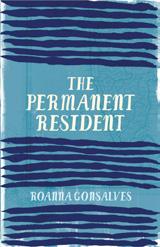

Amazing!
Rajni Luthra wrote: Woohoo Roanna! Roanna Gonsalves wrote: Thank you for your generous words, dear Indian Link






We paid a tribute to brave soldiers on the occasion of Anzac Day. Betty Jager wrote: We in Australia honour all Anzacs, they will always be in our hearts.
If koalas eat mainly eucalyptus leaf, does that mean their breath is really fresh?
Aditi Mittal, Indian stand-up at Melbourne International Comedy Festival
Post a picture on Instagram of Indian Link at home, work or anywhere else in your life, using the hashtag #indianlink. We’ll select the best pic and publish it here.
This time’s entry is from @anonymouspumpkin: When a thoughtful headline stops me in my tracks


On the treadmill, thought I’d watch #SAvsAus. Watched two overs. Switched to Arsenal vs Stroke Harsha Bhogle, Indian cricket commentator
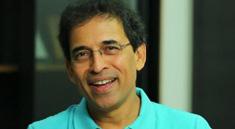
The call for justice that has roared in India against the repeated rape and murder of eight-year-old child
Asifa Banu in the country has been echoed here in Australia this week.
A group of 102 academics, writers, musicians and performing artists have voiced their protest against the terrible incident – and the Indian government’s slow response to it – in letters submitted to the Indian Consulates in Sydney and Melbourne.
Writer and academic Roanna Gonsalves, who was one of the signatories, told Indian Link, “You might think that it’s easy for us to live outside of India and make a casual comment now and then about affairs there. But we are connected by blood. India is our motherland and it is our duty to speak up.”
In the letter that was hand-delivered to Consulate Generals of India in Sydney and Melbourne on Monday, April 23, 2018, they state, “As concerned citizens of Australia and India, we are deeply invested in the ongoing health of our democracies, the growing bilateral relationship between the two nations, and in drawing attention
to and addressing the damage being done to both under the current Indian government.”
Calling for ‘Zero Tolerance After Asifa’, they demanded “immediate action in providing justice to Asifa and all other victims of sexual violence, to provide support and compensation to their families, and to restore the faith of citizens and the international community in Indian democracy by bringing the perpetrators to justice immediately.”
The letter reads:
April 23, 2018
To,
The High Commissioner of India in Australia
Subject: Petition with respect to Asifa Banu’s torturous rape and murder and to protest against the current climate of ongoing political atrocities towards Muslims and other minority communities in India
Sir, We are writing this letter, to express our deepest sorrow and shock at the abduction,
brutal and multiples rapes upon, and premeditated, cold-blooded murder of Asifa Banu, the eight-year old Indian girl from Kathua in the state of Jammu and Kashmir. Our condolences, belated and ineffectual as they are, go out to her family: Words fail to even imagine their indescribable pain as their daughter was sexually tortured for seven days, killed and dumped in a forest, and then denied burial in the local graveyard in January 2018.
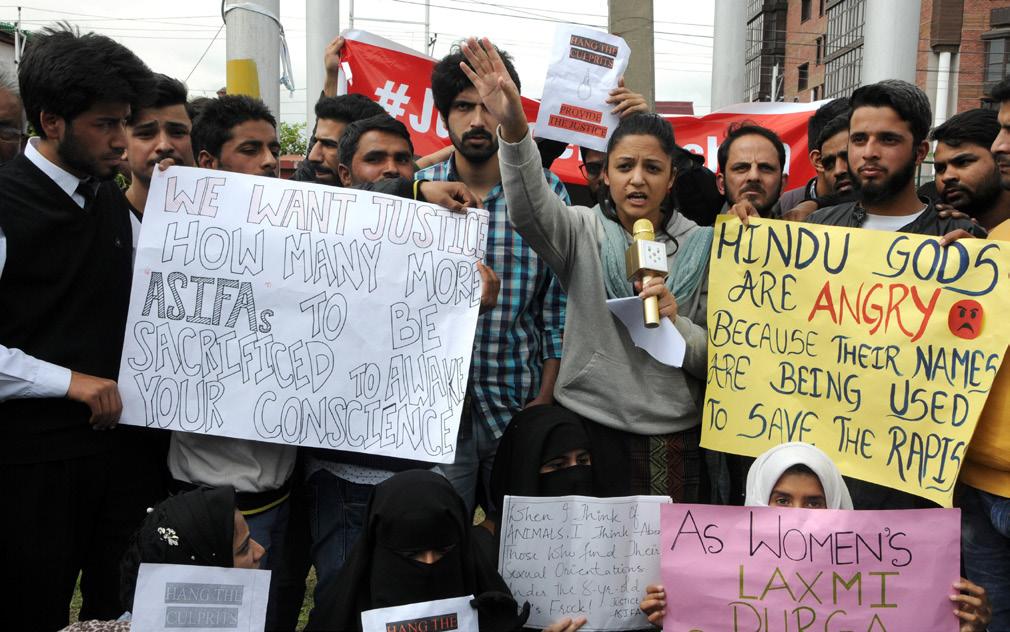
Through this letter we express our anger, distress, and mute hopelessness at the unjustifiable delay and coverups in the investigations to bring justice for a minor from the Muslim Bakerwal nomadic tribe, whose murder is not only reported to be a sexually-based crime, but also politicallymotivated by a campaign of deep hatred and ongoing discriminations against Muslims and other minorities in the current Hindu-majority government.
We are equally outraged at the protection being provided to the accused, who belong to the Hindu community in Jammu and Kashmir, and whose members conspired to commit this
horrific crime. This incident is one of the many heinous crimes being committed, reported and covered in domestic and international media, against members of the many minority communities of India on a regular basis ever since the current ruling government came to political power in 2014. The abuse of women and minors as fodder in these hate crimes, of using rape as a weapon of war against its own citizens, of engaging in overt and covert intimidation against those who dare to speak out, is the all-too-common face of the dastardly campaigns that seek to obliterate the existence of, and engage in a sustained drive against, Muslims and other minorities in India under the ruling Bharatiya Janata Party (BJP) government. We are a group of writers, artpractitioners, academics, and media professionals in Australia who are closely connected to India. As concerned citizens of Australia and India, we are deeply invested in the ongoing health of our democracies, the growing bilateral relationship between the two nations, and in drawing attention to and addressing
“India is our motherland and we are connected by blood. It is our duty to speak up,” Roanna Gonsalves tells RAJNI ANAND LUTHRA


A flourishing society also requires more than just freedom of speech; it requires security, stability, a just legal system and a vibrant economy.
BY MATT KEANAustralia is a country of great diversity. You can see it in the faces of the people that you work with. You can see it in the restaurants that line the main streets of our towns. And you can see it in the variety of religious and cultural events celebrated around the country: Chinese New Year, Diwali, Hanukkah, Ramadan and Christmas to name a few.


Gonsalves’ mind. “Of course, it’s a huge risk; anti-Modi views are not taken lightly and many journalists are being silenced for voicing their opinions. But we have no connection with party politics, we are part of a growing number of people who are becoming concerned about the disturbing trends in India.”
However, the treatment of the Aboriginal peoples in this country stands as a chilling reminder that tolerance has not always been embraced. The Cronulla riots similarly reminds us how quickly what we have achieved can be put at risk.
That is why freedom of speech is not absolute. In this country, it is criminal to disclose secrets which risk the lives of Australian soldiers. It is likewise a crime for a corporate executive to disclose market sensitive information to his mates. The law protects us from slander and protects privileged comments made to our lawyers.
be a deterrent to crime. Education is the only solution,” she said.
As a society, we recognise that these restrictions do not hurt our democracy or way of life. Indeed, we understand that they are necessary to maintain it. And laws against hate speech are no less necessary, because racism and bigotry tear at the heart of our social fabric.
Gonsalves is a well-known literary figure is Sydney, having arrived on the scene with her first book of short stories The Permanent Resident, that won the Multicultural NSW Award at the NSW Premier’s Literary Awards.

The proposed amendments to Racial Discrimination Act were put forward on the basis that the current wording of Section 18C inappropriately constrains our freedom of speech.

Perhaps it’s this growing concern and furore that has resulted in an ordinance passed by India’s cabinet last week, according to which offenders who rape girls under the age of 12 may now be subject to death penalty. But Gonsalves remains unconvinced of the efficacy of the “Death penalty makes for a great headline, but it will lead to more murders. Until now, women and children were being raped, now they’ll be raped and murdered. Who’s going to let the child live to be able to speak up? The death penalty was a kneejerk populist reaction, and it will not
That section makes it unlawful to do an act in public which “is reasonably likely… to offend, insult, humiliate or intimidate another person or a group of people” if “the act is done because of the race, colour or national or ethnic origin of the other person

There is no doubt that freedom of speech is important but it is important because of the role it plays in our democracy. Freedom of speech ensures that when you or I go to the ballot box we can make an informed decision about who to vote for.
This isn’t the first time the writer has taken up activisim. Back in 2015, she had gathered along with members of the creative fraternity in India under the auspices of the Kochi-Muziris Biennale 2014 umbrella to also express their solidarity with persecuted Tamil novelist Perumal Murugan.

Racism and bigotry leave people feeling exiled in their own home. They do not improve the quality of public debate nor do they assist the wise completion of a ballot paper. They are insidious because they attack a person because of their identity; their heritage. They imply that a person is inferior because of who they are. They are hurtful, divisive and can lead to individuals and entire communities feeling unwanted, unvalued and second-class.
Gonsalves may be right about education being the only solution, but it’s one that will take years to implement. For now, it’s clear that the Indian diaspora has become more vocal about Indian issues and they are demanding that authorities sit up and take notice.
As a society, we recognise that restrictions on free speech do not hurt our democracy or way of life. Indeed, we understand they are necessary to maintain it. And laws against hate speech are no less necessary, because racism and bigotry tear at the heart of our social fabric
Freedom of speech is necessary so that as a community, we can debate political ideas and so that individuals can have a say on decisions that affect them.
Section 18C ensures that everyone has a role to play in that debate.

Comments today can also revive memories of past wrongs. Unfortunately, few ethnic groups have been spared the pain of racially justified persecution. Examples such as slavery in the United States and the Holocaust are well known. In recent times, the a vibrant, rich and diverse society. A society not focused on the differences between us, but founded on the strengths our differences afford us. Section 18C stands, not as a threat to freedom of speech, but as a protector of the purposes which that freedom serves, and as a guard to an achievement exceptional in this time and rare in times before.
Matt Kean is the Member for Hornsby and Parliamentary Secretary for Communities.

A ourishing society requires more than just freedom of speech; it requires security, stability, a just legal system and a vibrant economy
essential
Laughter, they say, has no foreign accent. And among all the comics celebrating the universal appeal of humour at the 31st Melbourne International Comedy Festival 2018 were our very own Sorabh Pant, Aditi Mittal and Azeem Banatwalla.
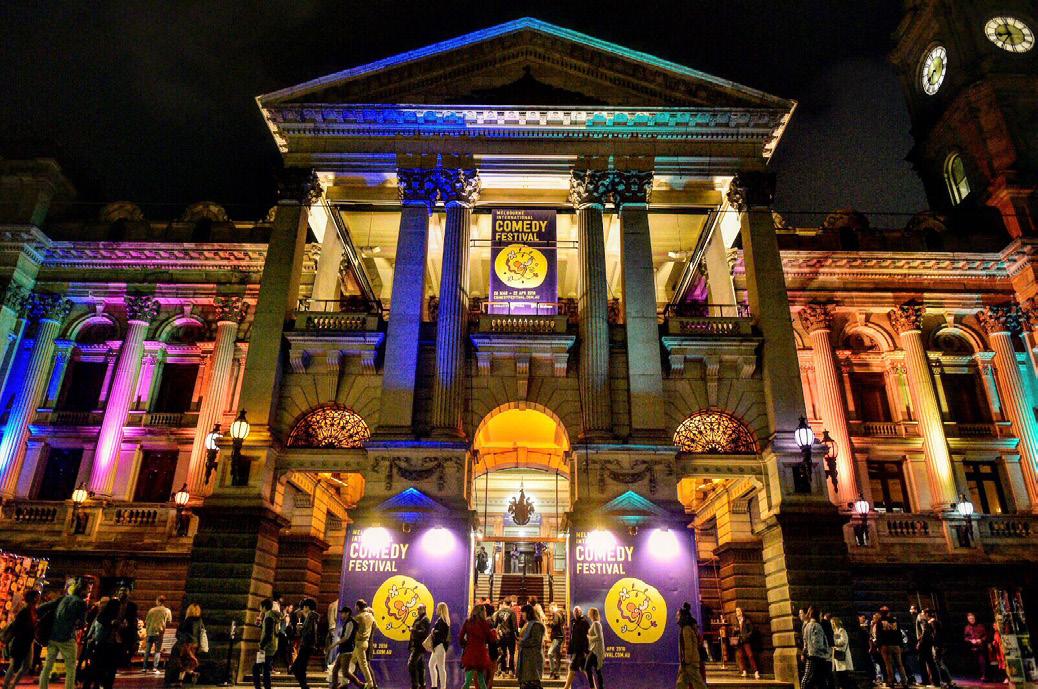
Held from March 28-April 22, this was the third largest comedy festival in the world after Montreal’s Just for Laughs and the Edinburgh Fringe Festival. The line-up of laughter makers included some exciting names from India bringing their own experiences to mainstream comedy, to create a wider and a more inclusive reflection.
We spoke to the three stand-ups who enjoy an enormous fan following back home and surely made some new ones here in Australia.
Aditi tells us that as a first-time visitor to Australia cuddling a koala is her top priority. “One of my doubts in life is: if koalas only eat eucalyptus leaf all day, does that mean their breath stays really fresh?” she wonders. A good question, and one that we can’t admit has crossed our minds.
Since all three of them were on virgin territory as far as the Australian audience
is concerned, did they have a specific plan of action? “I do not like playing on stereotypes,” says Azeem. “I prefer to report the truth of the matter. For instance, I could talk about how the Australian Government has a huge focus on cracking down on cigarette smoking in terms of price and taxes and it’s great to see them look at health at such a microscopic level.
“In India, however, we have different priorities, we are still trying to get toilets in people’s houses,” he adds.
Azeem quit his job as a travel writer in the end of 2013 to dedicate his creative juices to comedy. He thinks full time stand up is economically viable as a profession currently given its massive uptake in India.”
“Our generation of Indian comedians is lucky to have hopped on to this bandwagon at a time when comedy started booming,” observes Azeem. “We got onto our formative years fairly early on when there wasn’t a lot of competition, and we have also tried to help each other in growing off each other’s success. Starting out now would be a lot harder.”
He adds, “While there is no guaranteed income it allows a comfortable living.”
Aditi, who recently performed at the Edinburgh Comedy Festival, says Indian stereotypes are similar around the world. “Comedy has helped me set my own position in a room full of foreigners,” she reveals. “I can easily joke on where I come from and still feel a sense of belonging that

reflects on my content. Our generation of comedians have this in common that we all are in love with where we come from and we are willing to make fun of it.”
Sorabh claims he would rather talk about his take on world politics and other subjects, including Trump, from the perspective of a modern, urban Indian who travels a lot. According to him Australians play hard but are essentially nice blokes who are very willing to take a joke and give it back, making it fun.
Citing the example of his observation of Australian behaviour, he thought former cricket captain Steve Waugh was an absolute tyrant on field, sledging and willing to do anything in order to win, but as soon as he stopped playing he turned out to be the nicest person around.
Sorabh says he is generally impressed by Australian people and Australian talent and intends to watch a lot of Australian stand-up in between his hectic schedule. Responding to how career progression looks like in the comedy industry, Aditi does not think there is any linear promotion; however, she wishes to live a long life and continue to do comedy till she is 80 and beyond. According to her,
comedy is all about living and processing life as one gets on stage.
Sorabh on the other hand thinks his progression was ‘ass backwards’. He was a TV writer and did not necessarily start off with Open Mics; he started dabbling with comedy initially with clichéd jokes and had never thought he would end up in this profession.
All three concur that social media exposure comes with its pros and cons as far as their comedy careers are concerned. Azeem shares a recent experience in Melbourne where he walked into a Woolworths store and the attendant from an Indian background recognised him. “No matter how big a show you do, word of mouth can only go so far. I have done shows of 5000 people and if the video of the show does well then it still reaches half a million people across the world, creating a huge audience,” he says.
“I keep reflecting on our self-esteem as a people and what power we speak from,” says Aditi. “Do we speak from utter helplessness, power or anger, and where do we come from emotionally? Social media is one of the reasons we are famous. Sure, it is getting increasingly ugly and >
I do not like playing on stereotypes. I prefer to report the truth of the matter Azeem Banatwalla
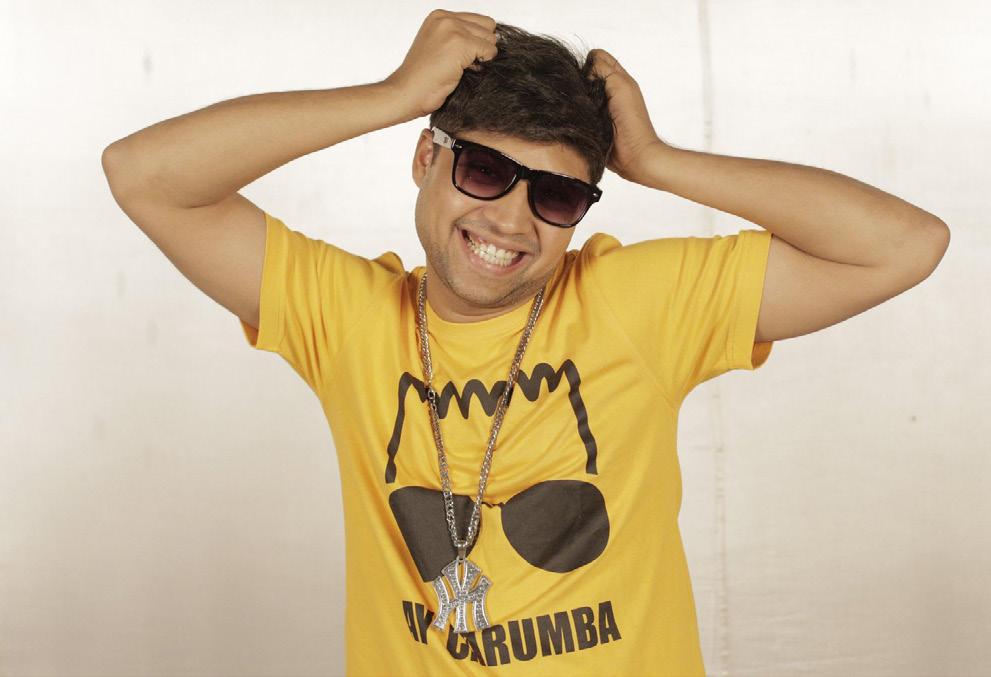
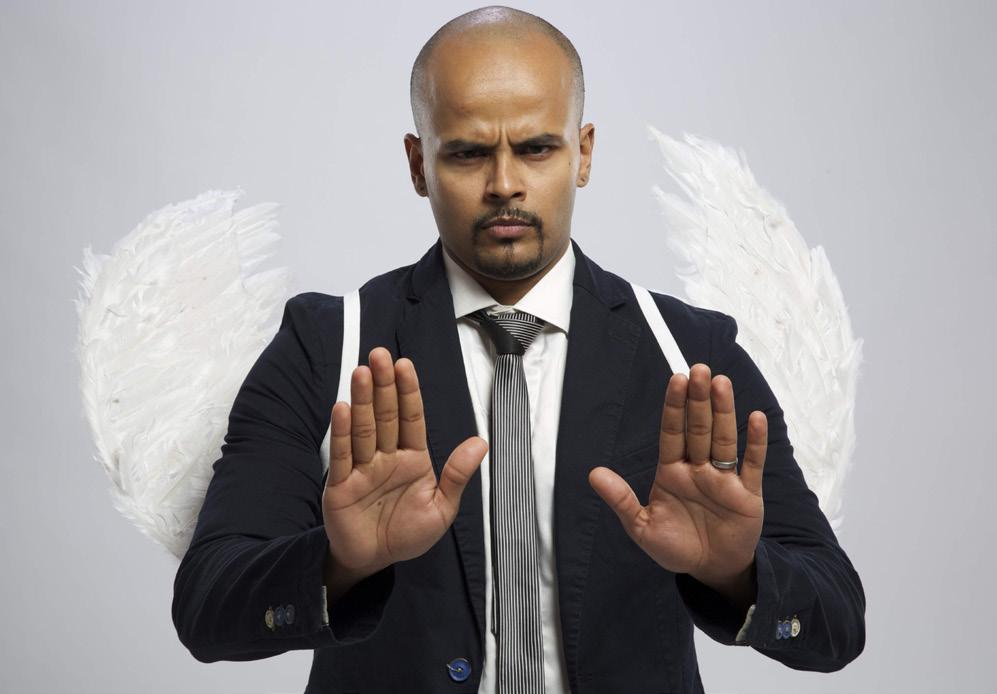
I got a lot of hate mail from Salman Khan fans Sorabh PantSorabh Pant Rahul Subramanian
> toxic, and we comedians do have to put up with a lot of flak on social media.”
Sorabh’s Rant of the Pant video series in 2017 garnered nearly 25 million views in a year and he has also done three Amazon prime media specials so he is certainly not complaining. “Everything gets exacerbated on social media. I got a lot of hate from Salman Khan fans for joking about his recent arrest. But I am not going to complain because most of our careers took off because of social media. You got to take the good with the bad,” he says.
One thing we tend to notice a lot these days among stand-ups is the use of expletives. Can comics be funny without using them? Sorabh claims he may have used the F-word a lot in the beginning, but not anymore, because it could subconsciously turn into a crutch.
Azeem, on the other hand, says it all depends on the emotion in that moment. “I do not add it consciously to my script but it can happen if I want to keep it natural. Most people tend to use some sort of profanity in their normal conversations if they feel strongly about something.”
Aditi thinks one of the hallmarks of comedy is to say what is on your mind. So if that means using an expletive now and then is fine. “If you use it to establish a connection in a normal conversation, that’s acceptable. But don’t use it as a filler,” she says.
It was fun for the broadminded at the Indian All-Star Comedy Showcase hosted recently by the Melbourne International Comedy Festival (MICF).

Integrating their niche experiences with the wider world, four Indian stand-up comedians prompted numerous laughs and a few guffaws over the hour-long show.
The spotlight was on religion, sex and the mundane, and the comedians deftly delivered their punches scoring comedic bullseyes.
Aditi Mittal as the host of the showcase cavorted about the stage telling her stories with unabashed glee. Yet the content of her show was nowhere as animated as her personality.
Aditi called out sexism and championed feminism with her jokes, and although there were hits as well as and misses, she revved up the crowd with every appearance.
Sorabh Pant delivered an assured combination of insightful punches and easy laughs. The overall energy was surprisingly low but his life observations helped him construct a polished 15-minute segment.

Rahul Subramanian ruled the comedic roost with his timing. His jokes were served deadpan, followed often by an imaginative pause that kept the audience suitably intrigued.
Masking his satirical sights under goo ness, Rahul jumped from one unrelated topic to another. Anecdotes of driving with his wife took up bulk of his entertaining segment.
A memorable bit was when Rahul got the men in the house to give him a cheer and the women in the house to give him a cheer. When they did, enthusiastically, he blamed them for ‘being sexist’ because why should women be in the house?
The last 15 minutes were taken up by Azeem Banatwalla as he touched interestingly on being a Muslim and provocatively tackled the idea of joking about his religion.
“If I said these things in India I would be bombed,” he claimed, as he remarked on the freedom of joking about Islam without raising bedlam, thanks to his broadminded audience.
The audience had more of a good chuckle than constant stitches and the hour passed too quickly.

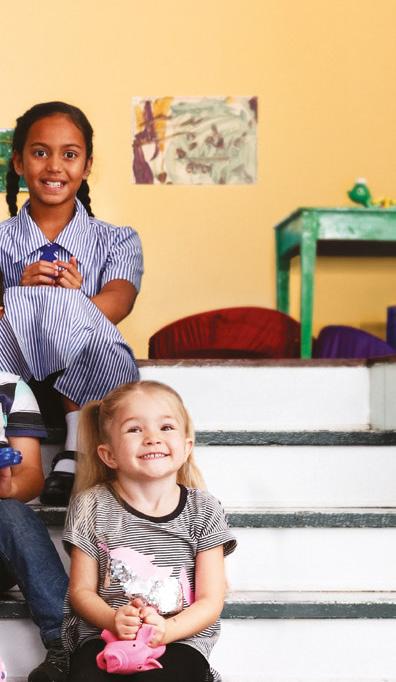
COMPLETE YOUR ONLINE FORM NOW THROUGH MYGOV
Starts 2 July 2018












The New Child Care Package will help parents with children aged 0-13 to work, train, study or volunteer.
One new Child Care Subsidy replaces the two current child care payments.
There’s also a Child Care Safety Net to help disadvantaged families and children with additional needs.









Changes to the annual cap will make child care more affordable for most families.
You need to provide some new information and confirm your current details NOW through myGov. Find out more at
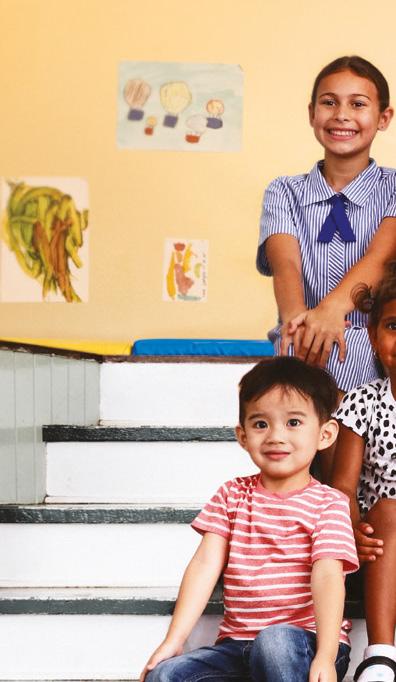
Victoria’s Immigration Museum is showcasing a figure not normally associated with migrant history: Mohandas Karamchand Gandhi, known today around the world as ‘Mahatma’ Gandhi.


‘Mahatma Gandhi: An Immigrant’ is a digital interactive exhibition combining photographs, recordings, archival footage and objects from the Mahatma Gandhi Digital Museum in Hyderabad, India with items relating to Gandhi’s India from Museum Victoria’s permanent collections.
The narrative that the exhibition takes the visitor through coalesces around Gandhi’s time as a barrister in South Africa, where he lived for 21 years. It posits that by the time he returned to India in 1915, the discrimination he had faced in South Africa and the social activism he had engaged in there had “transformed” him, “from Mohandas to the ‘Mahatma’ or ‘Great Soul’.”
“In the context of the current global climate of negativity and violence, the world needs a leader like Gandhi. We’ve brought this exhibition to the Immigration Museum to ignite the spirit of Gandhi and encourage
our visitors to pursue their own leadership potential to serve their communities,” says Rohini Kappadath, General Manager of the Immigration Museum.
There is no doubt that Gandhi is a powerful, even intoxicating figure, with immense international political, cultural and social currency. Everyone knows Gandhi, everyone calls him ‘Mahatma’. He is today an icon more than a human being, hence his talismanic appeal.
But ‘Mahatma Gandhi: An Immigrant’, presents itself as documenting the man, not the icon. And in this it fails dismally, because it obscures much more than it reveals about the flesh-and-blood, human, historical K Mohandas Gandhi and his role and identity in colonial South Africa. In fact, the narrative it presents is one fuelled by “selective memory”, as Claude Markovits writes of hagiographic representations of Gandhi in The UnGandhian Gandhi
The exhibition presents a straightforward, simplistic trajectory for Gandhi’s stay in South Africa: he came, he experienced discrimination against Indians, he fought against it, he developed his policy of Satyagraha, or non-violent protest, he took this back to India, and the rest, as they say, is freedom-fighting history.
However, the story of Gandhi and South Africa is much more complicated, dark and disturbing than this. As Ashwin Desai and Goolem Vahed write in their 2016 book
The South African Gandhi: The Stretcher-

Bearer of Empire, during his years in South Africa Gandhi “sought to ingratiate himself with Empire and its mission”. In doing so “he not only rendered African exploitation and oppression invisible, but was, on occasion, a willing part of their subjugation and racist stereotyping”.
For example, the petition of the Indian Natal Congress (for whom Gandhi was the spokesman) against the 1896 Franchisement Amendment Bill in Natal, which prevented Indians from registering to vote, stated that “the Bill would rank the Indian lower than the rawest Native”. After three years in Africa, Gandhi spoke in Bombay, saying, “Ours is one continual struggle against a degradation sought to be inflicted upon us by the Europeans, who desire to degrade us to the level of the raw
kaffir whose occupation is hunting, and whose sole ambition is to collect a certain number of cattle to buy a wife with and then pass his life in indolence and nakedness.”
Gandhi also supported the British suppression of the Zulu Rebellion in 1906, organising a stretcher-bearer corps of Indians to aid the British troops. In doing so, he hoped for, as Markovits writes, “an equality of a special sort: limited integration into white South African society”.
In response to this history, Rohini Kappadath says, “We acknowledge that Gandhi was a complex character and don’t seek to idolise him…this exhibition is more concerned with change and transformation and the impact people can have on the world.”
But “Mahatma Gandhi: An Immigrant”
New digital exhibition shows Gandhi in all his ‘Mahatma’ glory and captures the icon, but perhaps not the man himself
opts completely out of the complexity of Gandhi and the specificities of the South Africa under brutal, bloody colonialism in which he operated, instead presenting him as a nothing more than a benevolent icon for universal freedom. It’s the new and improved Gandhi, if you will, and it’s almost as if he stands outside history. So why does it matter? What is the impact of this editing and re-configuring
of the history and person of Mohandas K Gandhi, beyond the fact that it is the result of ‘selective memory’?
As I was peering into the glass case displaying clay figurines of Indians that were originally displayed in the Indian Court in the 1880 Melbourne International Exhibition, I overheard a woman beside me reassuring her son that one of the figures, a male figure in a palanquin being
borne by Indian bearers, wasn’t Gandhi: “He didn’t believe that one person should be higher than another.” The boy, sounding relieved, replied with something like, “I knew it couldn’t be him.”
But Gandhi did believe that ‘one person should be higher than another’, not only in his time in South Africa, but beyond, as Arundhati Roy writes in The Doctor and the Saint: “For more than half a century--throughout his adult life--[Gandhi’s] pronouncements on the inherent qualities of black Africans, untouchables and the labouring classes remained consistently insulting. His refusal to allow working-class people
and untouchables to create their own political organisations and elect their own representatives remained consistent too.”
By renouncing the real Gandhi - the deeply flawed activist for a very specific form of Indian independence - we remain in danger of oversimplifying the process of achieving truly universal equality, and of overlooking the forces of nationalism, classism, casteism and sexism that can complicate it, even for someone as gamechanging as he was.



‘Mahatma Gandhi: An Immigrant’ tries to keep it simple, but here’s the thing: simple stories might be the most appealing, but they are not how we change the world.

The exhibition is more concerned with change and transformation and the impact people can have on the world
Victoria Police recently started trialling body worn cameras (BWC) to see if they improve the Victorian policing environment. The cameras will record video and audio evidence and ultimately, increase transparency in interactions between the police and the public.

The flip side to the new development is the obvious question of privacy of citizens. We asked residents what they thought about BWCs, and here’s what they had to say.
Police may not always tell you when they are turning on the camera. However, the camera will usually show a flashing red light when it is recording and you are more than welcome to ask if you are unsure.

The body worn camera pilot program by Victoria Police is a welcome move for collecting evidence. Apart from a tool to collect evidence, these device can also potentially enhance the safety of police of cers and possibly deter potential offenders. In cases of police misconduct, the recordings from these devices can also be used to determine accountability. The cameras will essentially be an extra pair of eyes for the police of cers, but it’s important that they communicate all the appropriate information to stakeholders. I can only hope that the program is a success and every police of cer is equipped with a BWC.



I think cameras are a good idea in terms of police accountability, especially in light of the recent incident with Melbourne police where they ill treated a man with a disability. However, cameras and technology alone cannot be responsible for accountability. There has to be a structural support in place that independently investigates police behaviour. Police investigating their own, as it currently stands, compromises justice. Technology is a critical tool to ensure accountability, but it absolutely needs to be supported by a cultural change and by independent bodies that investigate misdemeanour and abuse.

I think it’s a great idea. Given the number of road accidents that occur nowadays, these cameras are a great tool for the cops while they undertake an alcohol or drug test, or even conduct vehicle stops. BWCs can be as credible a source of evidence as dash-cam videos, particularly in cases of family violence. I do hope, though, that they use them in above circumstances and not misuse their power. Like, what if they deliberately don’t turn on their camera? Also, the storage and dealing with privacy should be very strict and any laxity should invite serious repercussions. Overall, I think it is great initiative and should prove to be a great success.
It is a fantastic initiative! This will promote trust, honesty and integrity in the system. But we need to be mindful of the footage; one should make sure it covers the story from start to end not just half the conversation. And as soon as any recording is done it should go straight into a central database that is controlled by an independent body that is not linked with the police. This initiative will not only make Melbourne a better place to live but also help train police staff in case of unethical behaviour.
Any new technology has its pros and cons. In this case, the advantages are that there would be complete transparency and a huge boost to public relations for Vic Police. But some doubts are bound to be in people’s minds, like loss of privacy and how the recorded information is subsequently used. Besides routine policing, it will certainly help them in high pro le events like handling civil unrest. In my opinion, the biggest advantage is the objectivity these cameras will ensure because they will take away any subjective interpretation. Still, one can’t be sure. The proof will be in the pudding and it all depends on how they implement these cameras.
I am in favour of this camera. It’ll help the community to know what really goes on during police operations. It would, without a doubt, enhance transparency and accountability. Gathering video and audio evidence will enable tighter law enforcement.
Compiled by PREETI JABBAL
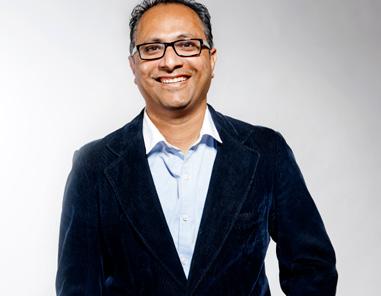







ENTERTAINMENT
Stand up: 5 May (7pm onwards)
Laugh India Laugh Fame with Chirag Wadhwan at Williamstown Town Hall 104 Ferguson St, Williamstown VIC 3061. Details 0406 997 339
Gurdas Maan Live: 20 May Gurdas Maan live concert in Melbourne. Details 0435 779 544/ 0426 809 499.
Swar Sandhya: 5th May (7.30pm onwards) An evening of Karaoke style singing of Hindi lm music. Brandon Park Primary School, 1-5 Ninevah Cres, Wheelers Hill. Details 0407 612 622.
Hindustani Classical Recital: 25 May (7:30pm – 11:30pm) Vidushi Ramneek Singh of Indore gharana, accompanied by local musicians, Bobby Singh on tabla and Bikram Singh Malhar on harmonium. 32
Tweed Street, Highett (The Gupta family residence).
Hindi Theatre: 25 May (7:30pm –11:30pm) Natyadarpan Theatre Academy presents Divya Rang, a collection of two powerful Hindi dramas. Chandler Community Centre, Isaac Rd, Keysborough.
Jashn-E-Bollywood: 26 May (6:00pm - 9:00pm) An evening of live lmy fun with Bollywood musicians, singers and dancers Dreambuilders, 37-43 Graham Ct, Hoppers Crossing, VIC 3029. Details 0411 429 598
Richa Sharma Live Concert: 27 May (7pm onwards) Sajda Night with a live performance by Richa Sharma at
Melbourne Town Hall 90-120 Swanston Street Melbourne VIC 3000. Details 0401 544 962.
WORKSHOP
Dance workshop: 27 May (9:30am and 11:30am)
Disha’s ‘Dance for Dignity’ Bollywood dance workshops will be raising money for ‘Share the Dignity’, for women facing nancial crisis due to domestic violence and homelessness in Melbourne. Creative Events Space – Skydeck, 318 Chapel Street, Prahrahn. Details 0418 860 460.
COMMUNITY
Indian Business Women Network Meeting
3 May (10.30am – 12.30 pm) Mezzanine Café and Lounge, 11 / 211 Leakes Road, Truganina. Details www.facebook.com/ IndianBusinessWomenNetwork
Indian Professional in Victoria (IPV): a non-for-pro t, membership-based and member-owned association that aims to train and support Indian professionals and entrepreneurs through workshops, seminars, webinars and mentoring programs. Membership details http:// www.ipv.org.au
Indian Community Mental Health Support Group

4 May (2:00 pm – 4:30 pm) Every rst Friday of the month at Yarra Plenty Regional Library (Mill Park Library), 394 Plenty Road, Mill Park, VIC. Details www.mindaustralia.org.au or 1300 554 660
MANAS Mental Awareness and Networking Support
5 May (4:00 pm – 5:00 pm) Support and contribute to community mental wellness. Venue Jindi Family and Community Centre, 48 Breadalbane Avenue, Mernda, VIC. You can join the session, if you are: A person who have or had experienced mental health concerns. Caring for a person experiencing or experienced mental health concerns. None of the above, but for you mental health matters and you wants to contribute to community at large. Details Prabhat Sangwan 0402 459 642
Mother’s Day Special
6 May (12 noon – 6.00pm) The Indian Bazaar hosts a Mother’s Day Market at Italian Sports Club Of Werribee, 601 Heaths Road, Werribee
12 May (12pm - 5.00pm) The Indian Bazaar hosts a shopping extravaganza at Epping Memorial Hall, 827 High St, Melbourne Details Shwetali 0412 455 283
Mother’s Day Bollywood Night
May 11 (7.00pm – 10.30pm) Om Music Group Australia presents Old & New Hindi songs with live music. Venue Café Brooklyn, 600 Geelong Road, Brooklyn. Details 0422 028 076.
Indian Cooking Class, Bentleigh
23 May (5:30 pm – 8:30 pm) Organised by Foodie Trails, learn to cook a Thali meal with over 5 items on the menu from an entree, to main course and side dishes. In this 3-hour class, you will also learn also about the culinary heritage behind it that makes every element of
it so important to a balanced diet. Take home a recipe pack. Venue Two Kings Café, 353 Centre Road, Bentleigh. Details www.foodietrails.com.au
EXHIBITION
Mahatma Gandhi: An Immigrant
Until 15 July (11.00am – 4.00pm daily)
This digital interactive exhibition honours the period of Gandhi’s stay in South Africa and his subsequent personal transformation from this experience. Immigration Museum, 400 Flinders St, Melbourne. Details 03 9927 2700
EVENTS AT AUSTRALIA INDIA INSTITUTE
Drop in Chai 4 May (2.00pm – 3.00pm) Come and chat to other South Asia enthusiasts over samosa and chai at the Institute’s Barry Street of ces and catch up with what others are doing in relation to India. Feel free to bring announcements or new publications. Drop in Chai is free and open to students, staff and members of the public. Drop in Chai events take place on the rst Friday of every month from March to November. Venue Australia India Institute Seminar Room, 149 Barry Street, Carlton.
Question Marks Seminar Series
10 May (1.00pm – 3.00pm) “How is public authority linked to violence in South Asia?” Listen to Dr Bart Klem, Dr Jeff Redding, Dr Jonathan Balls, Dr Haripriya Rangan, and Professor Robin Jeffrey. Venue William Macmahon Ball Theatre. Old Arts Building. University of Melbourne, Parkville. Details www.aii.unimelb.edu.au

The Australian Border Force protects Australia. They work to prevent dangerous items like illicit drugs and firearms from crossing our border, and to stop visa fraud and the trafficking and exploitation of foreign workers.
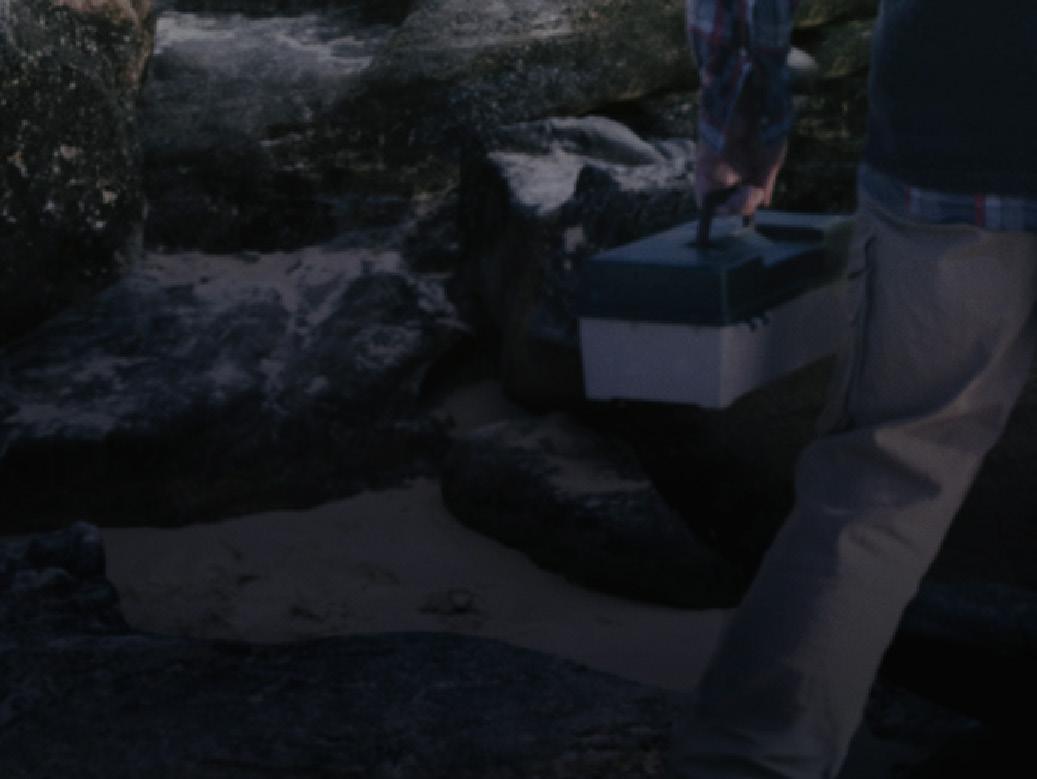
But sometimes, threats can be detected within our border. So if you see something suspicious – or maybe something just doesn’t feel right – flag it with Border Watch and help the Australian Border Force keep our community safe.






Amma,
In your eyes you cradle the world, the world you have made me brave enough to face, and audacious enough to change.
In your lips you hold pearls, pearls of wisdom and of strength, for when I cast doubt upon my own.
In your heart, Amma, that’s made of, gold, steel and stardust, you espouse empathy to the many truths of our fellow humans, and the tenacity to challenge our own ignorance, to surpass the meekness of the mundane to set forth and seek my own fate.
And, through it all, in your hand you hold mine, guiding me through the unknown, from my rst steps to my last, my Amma.


My mum has received some interesting phone calls from me over the years, and as usual, she always knows what to say, no matter what the situation is. A memorable phone call happened very recently when I asked my mum to send my laptop to my of ce via an Uber after I’d accidentally left it at home. Bless her! She put the laptop in two bags with multiple padlocks, and wouldn’t let the Uber driver leave till she sussed him out. If that’s not top level security, I don’t know what is. Thanks, Mum!
I’ve rung my mum in panic many times. Like when I left my sports gear at home. When I left my music instrument at home. When I left my homework at home. When I left my hat at home. When I left my lunch at home. When I left my blazer at home. When I left my English novel at home. Once, when I left my bag at home. This happened all the way through school, from Kindergarten to Year 12 (sorry, Mum!) Towards the end of school, when you thought I would be more independent, I still had to seek mum out when I had trouble with the corsage for my formal date: she wanted one with a real string tie, not an elastic, and I didn’t know how to tie it! Mum became my practice test. And yes, only recently, when I had too many beers at a party, I rang her to come pick me up. You know what they say… you can always count on mum!
Whether it’s recipe rescue or fashion faux pas, mums are just a speed dial away. Here’s a toast to those super-women in our lives on her

At times, it has felt like my life has been peppered by a series of little panics, but my mum has always come to the rescue. I had a slight wardrobe malfunction involving my saree while dancing at my cousin’s wedding. I was morti ed and needed emergency fashion services. As it so happened, it was nothing that my mum, armed with safety pins and needle and thread, couldn’t x! Mum is also a fantastic cook, which as a result has meant that I didn’t cook much at home. Over the summer, I moved to Melbourne to pursue a summer job at a law rm and decided one night that I wanted to make some Mexican food. I bought the ingredients but realised halfway through sautéing the chicken that I really wasn’t sure what to do next. I was even more apprehensive about ruining someone else’s kitchen with my culinary quest, so I immediately called Mum for help. She calmly talked me through what to do step-by-step and the dish was actually edible, thanks to her! Being able to dial “1800-MUM” is a much-needed lifeline, and one that I’m sure, even years from now, I’ll never stop needing.
I had my HSC exam on 28 October and my mate messaged me “Are you all set for tomorrow?” at 12:15am on 27 October. I thought he must be kidding and I told him the exam is day after and not tomorrow. He told me to check the date and without realising that it’s 12am, I just saw the date and freaked out and screamed “MUM!!” A few seconds later, I saw the time and realised he was factually correct but also got to know that when in trouble, the rst person you think about is your mother.








I have called my mum so many times I have lost count. But the one that I remember recently was the rst day of school when I left my laptop at home. It was an emergency (aren’t they all?) because my class was about to start so she didn’t have time to dress and instead had to come in her PJs. Now if you don’t know my mum, she is incredibly fussy about wearing the right thing to the right place, so she was not in the least bit impressed. On top of that I missed her call when she arrived and she had to step out in her pajamas to hand the laptop to my classmate. And yes, I copped it that evening when I got home – not so much for forgetting my laptop but for making her commit a ‘wardrobe sin’. That’s so my mum! But I love her heaps.



When my sister and I were in Year 7 we started taking the bus back home from school. Because the bus only came every 30 minutes, we decided in our in nite wisdom to take a bus from the opposite side because there were more buses with the same number. We thought it’d drop us near home but on the opposite side, you see. After half an hour of checking google maps, my sister and I began panicking because the bus was going in the opposite direction of where we needed to be. We called mum who calmly asked us to explain the situation to the bus driver. I could sense the panic in her voice as she instructed us not to get into another bus. Unbeknownst to us, mum had to leave work early and eventually she picked us up. Thank god for her! My sister and I were dreading explaining everything to her, but when she saw the two of us, scared and tired, all she did was laugh. Phew!


 BY RAJNI ANAND
BY RAJNI ANAND
Having participated in the ANZAC Day Parade for a few years now, many of those who march as part of the Indian contingent are beginning to feel that perhaps India should organise its own memorial event.

Indian involvement at Gallipoli in 1915 is now a well-recognised fact, with documentation including photographs and letters unearthed after many years.
Some 1.3 million Indian soldiers served in World War I, and over 74,000 of them lost their lives, 1,400 of these at Gallipoli alone. Many were awarded the Victoria Cross honour.
Just the like the Aussies and New Zealanders, they fought a war in a strange land far from their own, and against an enemy they knew little about.
The Indian contingent at Gallipoli comprised the 7th Indian Mountain Artillery Brigade, 29th Indian Infantry Brigade, Indian Supply and Transport Corps, and the 108th Indian Field Ambulance, among others. They served there from late April 1915, through the August offensive, until the final evacuation in December.
“If Australia and New Zealand can go to
Gallipoli every year to lay a wreath to the memory of their soldiers, why shouldn’t India?” asks Col Nilesh Bansal (Retd), who has been a proud ANZAC Day participant in Melbourne since 2013.

“I’ve spoken to Indian officials about this,” Bansal reveals, “and I am saddened to learn that apparently the Indian political system and bureaucracy do not recognise or honour conflicts that took place before 1947, considering the participants as ‘part of British forces’.”
Major General Ranjit Nadkarni (Retd), Vishisht Seva Medal, who led the 20-strong Indian contingent at Melbourne’s ANZAC Day parade again this year, feels that the annual ceremony including the dawn service, parades
and observances at RSL to honour our veterans, mean a lot to men in uniform.
“These ceremonies give respect to all armed forces personnel,” he tells Indian Link. “They are made to feel a valued section of the community. In India we don’t get such recognition, at least not to this extent.”
He adds, “I would like to see something of this nature in India, definitely. We do have the Republic Day ceremony but it is a mixed affair, with various other services and states taking part.”
Taking a cue from the Australian observance of ANZAC Day, he goes a step further and says that perhaps India should set aside an annual day to celebrate the nation’s military history.
“I think the Armed Forces must be given due recognition for their efforts, and their service remembered. The 1971 conflict, for example, in which I myself participated, created international history, giving rise to the birth of a new nation, Bangladesh. And over and above their roles in conflict and border protection, the Forces take on many challenges as part of their humanitarian duties such as during natural calamities. The nation owes the Armed Forces. We should set aside a day for military personnel alone, besides Republic Day.”
The Indian Consulate in Melbourne hosts a lunch every year to honour the Indian marchers, and both Bansal and Nadkarni have expressed the sense of pride they feel, as members of the community – both Indian and mainstream – come up and greet them as military officers who served their country with devotion.

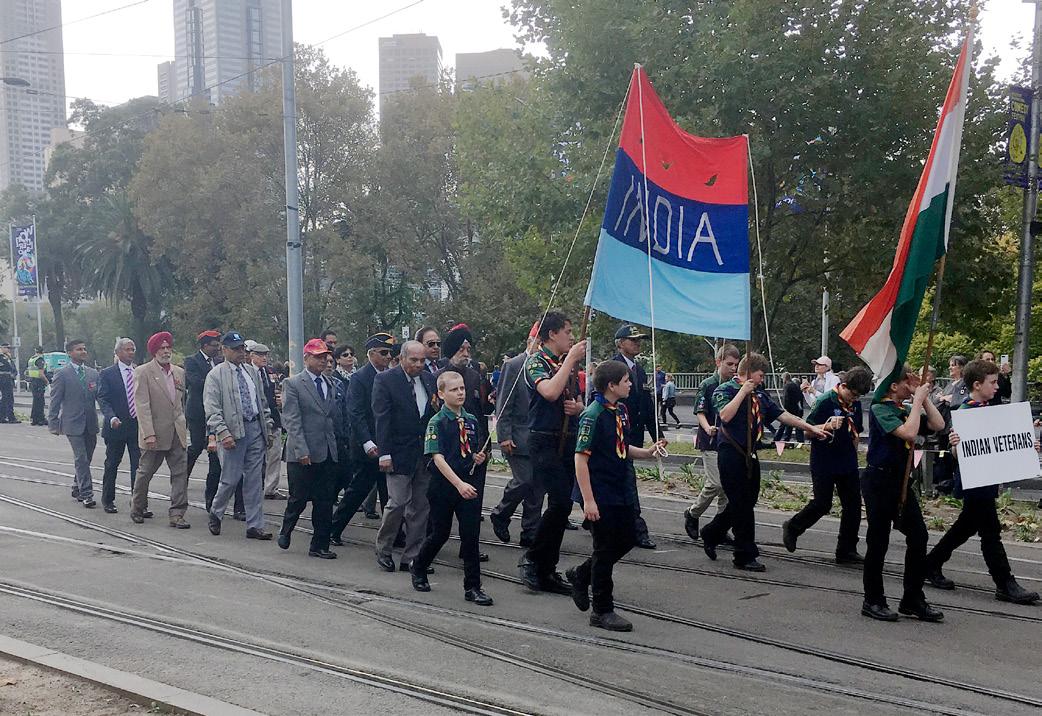
“Of course, there are people who recognise and value our service in India also,” Nadkarni reveals. “When I go to the bank in India for instance, I am amazed at the regard shown to me simply because I am a soldier. But there’s no public forum for such acknowledgment. I think it can be done: the retired community will happily work alongside the serving community to make this happen. Such a move will do the country proud, I feel.”
Gen Nadkarni served in the Indian Army for 38 years. As an Infantry officer he saw action in the 1971 war as a young major, and later in Kashmir fighting terrorists.
As part of his long career he also served as Chief Instructor of the Army at the prestigious Defence Services Staff College at Wellington, Tamil Nadu.
“I taught military history and am fully aware of the battles that took place in Gallipoli in 1914-15,” he offers. “My
brigade the 1st Battalion of the Sikh Regiment was particularly active there and this is a great source of pride for me. The Gurkhas and others from India did their bit equally valiantly and we are proud of their service and sacrifice.”
Having marched in the ANZAC Day parade for the 11th year this year, he says, “I felt proud to be Indian and an ex-Army officer. I felt proud that there is some recognition for Indian soldiers.”
His words are echoed by Col Bansal, who describes in some detail putting on his regimental cap and tie and pinning on his medal accoutrements in preparation for the parade. “I was proud to be marching as a representative of our veterans who participated at Gallipoli,” he tells Indian Link

Having served in the Indian Army for 22 years, he counts his 12 years in Kashmir (including Siachen) in counter insurgency
operations as his high points. He talks with pride about raising and commanding a Brahmos (surface to surface supersonic cruise missile) regiment, making it to the prestigious Defense Services Staff Course and serving as part of the United Nations Peace Keeping Force in Ethiopia and Eritrea.
“Walking through the WWII cemetery in Ethiopia, I came across tombstones of many Indian soldiers,” he recalls. “They lie there forgotten. If we don’t honour our soldiers, who else will? It’s good to see our current prime minister, Narendra Modi starting to make an effort now.”
Many Indian Army regiments do so at their own levels, he points out. “It is heartening to see that the old battles and sacrifices are still remembered at least at this level. I think that we as a nation should honour our soldiers; whichever banner they fought under, they were Indian at the end of the day.”
Perhaps India should set aside an annual day to celebrate the nation’s military history




























































































































































































There is a vast ocean of literature in the vernacular languages of India, and each language has its own rich history and traditions. Alas, most of us have little or no idea of what they are. Unless these works are translated into another language or English, we don’t really get to enjoy or experience those fantastic literary works.
Often, when reading books by authors of Indian languages, I am struck by the sad fact that apart from their own language, they are likely to be more familiar with English language literature than towering writers in other Indian languages such as Valalthol in Malayalam, Kshetragya in Telugu and Bharati in Tamil, to name a few.
So we must thank Poonam Saxena for translating the late Rahi Masoom Raza’s searing Hindi-Urdu novella, Scene 75, written in 1977 (Harper Perennial, 2018) because for the first time, non-Hindi/ Urdu readers can finally get a taste of that author’s literary tour de force.



Raza skyrocketed to fame as the scriptwriter of B R Chopra’s TV serial Mahabharata in the 1980s, although he had worked on a range of ‘serious’ and ‘masala’ movies in Bollywood earlier. His considerable writing skills had been


recognised when he was awarded ‘Best Screenplay’ twice.
Lurking underneath the Bollywood banter, though, was a more serious author and social critic who had already written acclaimed books such as Aadha Gaon and Topi Shukla that pilloried hypocrisy and greed in modern India. When Abdul Hamid, an Indian soldier from Ghazipur, who won the highest honour for bravery, the Param Vir Chakra, for single-handedly destroying seven enemy tanks in the 1965 war, the then Defence Minister YB Chavan called upon Raza to write his biography.
Here was an author capable of digging deep into society and laying it bare in incisive prose while simultaneously making his way in the world of commercial Hindi cinema.
Although he had written screenplay for some memorable Bollywood movies, he often found himself quite repulsed by Bombay movie industry of the 1970s in many ways. This conflict between the commercial writer and social critic is what dominates the hero of this 1977 novel, Ali Amjad.
Amjad comes to Bombay from Benaras to write for films, but is stymied by the industry’s rank hypocrisy. In his description of it, Raza brings to the novel
insider’s
an insider’s understanding of Bombay and the Bollywood movie industry: ‘fixed’ film awards, manipulative heroes, promiscuous heroines and social climbers and scores of hangers on, who wait desperately for that first break in the movie industry.
It doesn’t take a genius to figure out that Scene 75 is largely autobiographical. Raza was born in Ghazipur in Eastern Uttar Pradesh, and studied at Aligarh Muslim University, but developed a distaste for religion quite early on. His novella does not skirt the issue of ‘Muslim as the Other’ though. Indeed, this theme — the question of identity and Hindu-Muslim relationship — haunts most of Raza’s novels. He evokes the experience of being a Muslim in India better than most other writers.
Although written in the 1970s, Scene 75 retains its freshness and relevance, and does not feet one bit dated. The writer’s literary style is reminiscent of the famous Urdu writer, Saadat Hassan Manto in its candour and minimalism.
Saxena, who has earlier translated another Hindi classic, Gunahon ka Devta by Dharamvir Bharati, does a commendable job of retaining Raza’s voice, and avoids the temptation of superimposing hers on the original.
We now turn our attention to another recently translated work – this time considerably older than 1977! The famous play – Mricchakatikam: The Clay Toy-Cart, was written in Sanskrit 2500 years ago purportedly by Shudraka – and is of a slightly different genre than Kalidasa’s. Ever since it was rst translated into English in 1905 by Ryder, it has been adapted and performed on stage in the West many times.
The theme of the play has a certain universal appeal: the plot of two starcrossed lovers caught in a larger political intrigue that is being played out lends itself to adaptation into any culture or time. It has all the hallmarks of a thriller: Vasantasena, a nagarvadhu or rich courtesan, is pursued by a poor Brahman Charudatta, but their romance becomes intertwined with palace intrigues when the King’s brother-in-law covets Vasantasena as well.
That a play two and half millennia old can resonate among so may audiences worldwide is a testament to the genius of the author. The new translation is by Padmini Rajappa and although it is not quite as brilliant as Ryder’s, it is de nitely worth a read, especially if you have not read it at all in any of its translations.
he con ict etween the comme cial writer and social critic is what dominates the hero of the novel
Poonam Saxena manages to capture the essence of the original Hindi-Urdu novel in her rendition
There’s no doubt parents are the best advocates for their own children. However, advocacy, commitment, love and support should not become a career for parents that displaces personal growth, paid employment or defining oneself outside of the family. Let’s look at the difference between healthy advocacy and unhealthy blending that stops both, parents and children from growing.
Each year I meet dozens of hands-on, interested and engaged parents. They are vested in the success of their children. These parents are appropriately involved, curious about the children’s day, and spend time with their children in both play and more formal learning activities. They are close, but not their child’s only and best friend.
Parents are expected to advocate for their child. After all, not many others will - especially in a world where personal value is measured by externalities. These externalities take the form of certificates, ‘likes’, ‘shares’, ‘views’, ‘comments’ and other bubbles that burst on contact with air. Children however deserve better than self-centred, ‘esteem’ based, or debased, externalities.

Advocacy takes best form when parents are aligned with educators, sports coaches and other mentors. Advocacy helps a child be noticed when they are just another uniform in a sea of uniforms. In this regard, a teacher may need to be informed of a special need requiring remediation or extension, an interest, a transition, a personal family matter or other factor that can impact on learning or involvement.
Professional educators will not be afraid of an advocate and will not characterise them as “Tiger parents”. After all, professional educators know that parents are legitimately most vested to support their child who cannot speak for themselves.
The other parents I meet each year are those lost in their role. Indeed so lost, that some are not separate from their child. Some members of this group of parents take their child’s utterances as
truth, are continually astounded by their child, and treat their child as an adult equal. These parents make their child
vulnerable, reduce their resilience and are unable to set limits. They are over-caring and overbearing. They cannot see that their lack of separation is actually culling their child’s growth. These parents do not trust educators and continually look for signs that their child is not being valued, included, recognised or acknowledged.
Others in this group are Amy Chua’s “Tiger parents”. Their input goes so far beyond advocacy that it could be classified as abuse. To these parents, educators will say (but alas not out loud), “I never need to know upon greeting you, what school your child attends or what university course they are doing or what
they want to be when they ‘grow up’. Nothing could be less important to me. For what matters is that your child is safe and happy, not defined by brands or have a self-worth based on where they walk or how they talk, or what they have to be for you to value them.”
A third group of parents who need separation from their child are those that are too involved in the school, afterhours activities, and in every facet of their child’s life, year after year as they go through schooling. In primary schools, these parents volunteer to assist in-class, but really spy on their child, and compare their child to others. They get on the P&C ostensibly to contribute to the school, but really so that they can shape the school around the possibility of a future school leadership position for their child. The teacher’s ‘best friend’, these parents are reliving their childhood through their child, reconciling every hurt, every lost opportunity, every time they did not get noticed.
Unfortunately, in this approach their child essentially disappears.
This last group of parents are so vested they can forget to think of their own needs. And this is the essential point. For time brings change, increasing independence, a partner, and, for children intent on growing, questions and re-definition.

Parents who live vicariously through their children must be asked this question, “Who will you be when your child leaves?” Years of sacrifice, of trying to reconcile a lost childhood, can mean that parents miss their own life yet again.
All parents must have a set of personal goals that stand in the world outside of their child’s world. This can mean returning to paid employment, developing an interest, creating a business, engaging in further education or something else. This of itself will be a powerful model for children to follow. It will mean that any advocacy role will be balanced against the parent’s pursuit of personal growth. Parenting involves sacrifice, commitment and balance. Balance means being allowed a life, whilst giving the child their own unencumbered life at the same time.
All parents must have a set of personal goals that stand in the world outside of their child’s world
Overprotective parents stop their children as well as themselves from growing



 BY JYOTI SHANKAR
BY JYOTI SHANKAR

We often travel to take a break and escape from our usual lives, meet new people, bask in beautiful surroundings and experience exotic adventures. Our recent trip to China provided all these elements. Shanghai, with its skyscrapers and magnetic levitational trains, seemed way more modern than Sydney.
The sceneries around Yangshuo’s mountains and those at Zhangjiajie, depicted in the movie Avatar, were picture perfect. Coming face to face with the rows of terracotta warriors in Xi’an transported us centuries back in time. I realised, though, that unconsciously I was longing for familiarity, when random Indian ‘encounters’ and links during our journeys became our trip highlights.
For starters, a group of 12-year-olds
accosted us on the streets of Yangshuo, asking us if we knew Aamir Khan. These young girls were looking to polish their English-speaking skills. They had seen Dangal, 3 Idiots and loved Secret Superstar Few people spoke or understood English in China, so it was wonderful to see their enthusiasm in communicating in English and their familiarity with Indian movies. Of course, that’s not the last of Bollywood we encountered. Walking around the leafy, chic French Concession in Shanghai, we stopped in our tracks when the face of Salman Khan as Bajrangi Bhaijaan stared from a poster in Mandarin. Our Madarin was limited to Ni hao and xie xie (thank you) but we soon learnt that Induren meant Indian when we heard the word referring to us, many a time.
Visiting the Shanghai Urban Planning Museum was interesting to see how the city had evolved from the early 20th century to the present day modern metropolis. A street scene drawing of the early 1900s with the caption explaining how Sikh policemen once patrolled the streets of Shanghai, startled me. These
statuesque men in red turbans were brought into the Shanghai Municipal Police by the British. Unfortunately, none of their traces now remain except in museums and archives. Most were repatriated back to India in the 1930s, while others returned after the 1962 IndoChinese war.
We spotted Modi’s picture on the city wall of Xi’an, which was the city where he began his visit to China in 2015. Like us, Modi also visited the Giant Wild Goose Pagoda in Xi’an. It was originally built in 652AD to preserve the Buddhist sutras and relics brought to China from India along the Silk Route by the monk Xuanzang. Most of us know him as Hiuen Tsang from our history books at school. This temple had an important role in the transmission of Buddhism.
Xuanzang travelled the length and breadth of India, keenly observing the social, religious and political conditions of the 7th century. His travel memoirs are valued for their truthful depiction of life in India during that time. The statue of Xuanzang now towers over the city of Xi’an, which was gaily decorated by
buntings and lanterns from the recent Chinese New Year. Strangely, Xuanzang’s temple and its murals took me back to India of the yesteryears.
A plaque with a message from exPresident Pratibha Patil welcomed us at a Buddhist temple built in the Indian Sanchi Stupa style at Luoyang. We were in this city eager to visit the Shaolin temple, fascinated by movies such as The 36th Chamber of Shaolin and Enter the Dragon Students from all over the world come here to train in Shaolin kung fu which combines Zen Buddhism with martial arts. Another Indian link we learnt of here took us by surprise. It is believed that a monk called Bodhidharma founded Shaolin kung fu and Zen Buddhism. He is believed to be the third son of a Pallava king from South India. Some believe that kung fu originated from kalaripayattu, a martial art form still practised in Kerala today. Whatever its origins, the Shaolin Temple is still revered for its teachings and will no doubt continue to spur many more movies about its legends. China, too, with its fascinating history and surprising Indian links, will beckon us again for sure.
In Shanghai, we were surprised to see Salman Khan on a Bajrangi Bhaijaan poster in Mandarin
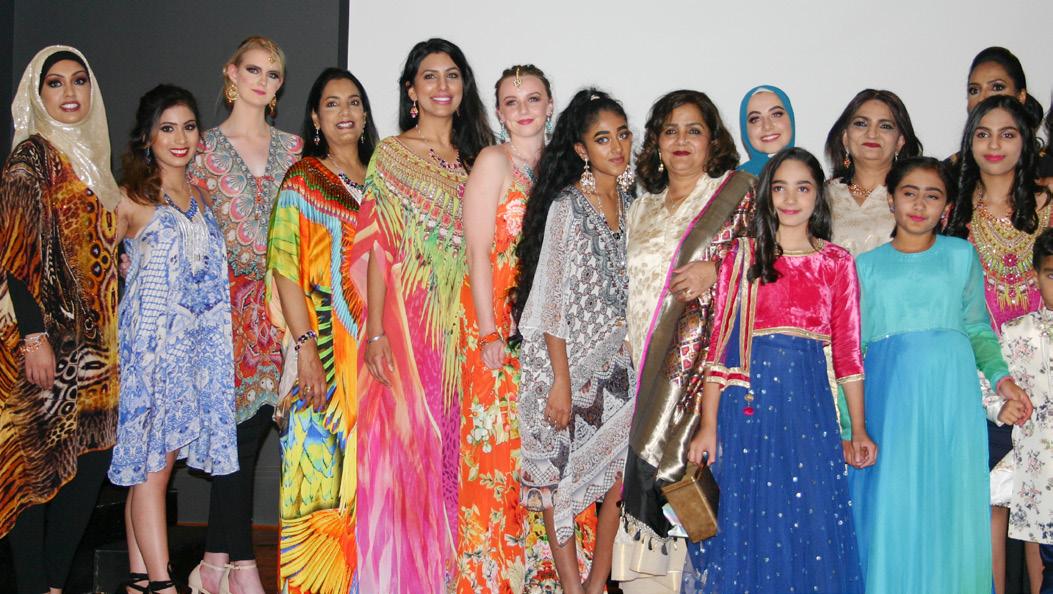
 BY PREETI JABBAL
BY PREETI JABBAL
Local Indian designer Alka Chopra’s debut fashion show, held recently at The Manningham Hotel, would have you believe that sparkles belong where they can be seen.
A joyful mix of vibrant colours and embellished fabrics took centre stage with the emphasis clearly on timelessness rather than the ephemeral.
The energy that fuels Alka’s collection was on display as women of all ages and sizes sashayed in various attire.
Focussing attention on the fall of ornate lehengas and the sensuousness of vibrant kaftans, the audience immersed themselves in the grandeur of Indian fashion.
The collection incorporated Indian traditional wear with a contemporary edge; it was a wearable and accessible collection that would make heads turn on the streets, for all the right reasons.
Alka prides herself on being one of

the first few to bring Indian fashion to Melbourne on a commercial basis. She currently operates from a boutique on trendy Burke Street and her label offers ready to wear and semi-stitched collections handpicked and sourced from India by Alka.
“I have been in this business from the early 90’s and have been meaning to have a proper show like this for a very long time. I am glad my dream has finally reached fruition,” Alka told Indian Link
“I believe that my collection provides access to a special kind of femininity and I wanted to share my passion for fashion with everyone” she added.
The show was put together, within four weeks, in collaboration with stylist Zareen Zeenath.
Lawyer by profession and model by hobby Jennifer Zaman was the emcee for the afternoon.
Models from various multicultural backgrounds added the glam quotient and enhanced the versatility and universal appeal of Indian garments.
Serious haute couture with all its trappings it was not but there was enough style to create drama and provide theatrics
at an otherwise simple show. The audience had the opportunity to mingle and shop post show and get first dibs on garments to which they had taken
a shine.
Part of the proceeds were pledged to Swastha Coorg India charity and Make a Wish Foundation Australia.
I believe that my collection provides access to a special kind of femininity











We offer catering services for all occassions:
• Birthdays, • Weddings,


• Corporate Events • Puja / Langar

We cater from 20 to 2000 guests and we suit your budget, taste and requirements.



Admit it. There’s never a bad time for chips. They are some of the best accompaniments for a movie, a game or any party. Most of us love to have a bag of chips when we travel or serve them when guests
Potato chips are a crowd favourite. However, the store-bought ones contain a lot of oil and salt, spices and preservatives. So, the homemade variety is far better. You can actually dehydrate them and fry them in batches whenever you want.

Ingredients
1-2 large potatoes
1 tbsp salt
1 litre water
Oil to deep fry
Red chilli powder or paprika, to taste (optional)
Method
Using a mandolin slicer, thinly slice potatoes.
Drop in boiling salted water for three to ve minutes.
Remove from water and spread evenly in a dehydrator tray. Alternatively, you can dry them in sunlight.
arrive. But having the regular store-bought variety regularly is both unhealthy - think oil, copious amounts of salt, chemical flavourings, colouring and preservativesand unaffordable.
What most of us don’t realise is that
Baked sweet potato chips are a low calorie snack and much healthier than the fried version. They taste great even without salt. You can also make baked potato chips in a similar fashion. Just remember that the oven temperature should not increase beyond 160 degree Celsius. Otherwise, you will be left will horribly burnt chips.

Ingredients
1 large sweet potato (around 300 grams)
1 tbsp olive oil
Method
Using a mandolin slicer or a sharp knife, slice the sweet potato lengthwise. Toss the chips in olive oil. Spread them evenly on a baking tray, making sure they don’t touch each other. Bake for 15 minutes at 160 degrees Celsius in a fan-forced oven. Flip the chips and bake again for 10-15 mins.
Once done, take out of the oven let rest in the baking tray for 5-10 mins. If you want to store them, let cool completely before putting them in a dry, air-tight jar.
chips can be made easily at home with some prior preparation. Because you are in charge, you can control the amount of oil and salt in them. Here are three types of chips, made using three cooking techniques – baked,
Dehydrate for 4-7 hours until completely dry and crisp. Store in a dry air-tight jar.
To eat, deep fry in hot oil until light golden brown.
Season immediately with chilli powder or paprika, if using.

Apple is a versatile fruit. You can eat it raw, juice, bake or cook it and, in this case, even dehydrate it. If you have a picky kid who just wants to eat munchies, apple chips are what you need. You are happy that they are eating healthy and so are they as they get to eat chips. You can use a dehydrator to dry these chips or alternatively just sun-dry them. A dehydrator is great in places where you don’t get adequate sun or in winters when you want to dry chips or crisps outdoors.
Ingredients
1-2 large apples
1 tbsp lemon juice
Method
Using a mandolin slicer or a sharp knife, slice the apple in thin chips. Toss them in lemon juice. Spread them evenly in a dehydrator tray.
Dehydrate for 4-7 hours or until crisp. Store in a dry, air-tight jar.

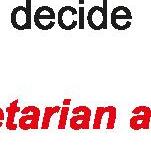





Match required for my sister, Aus citizen, Hindu Punjabi (non-veg) 5’0, slim/fair/ beautiful, 1988-born, Masters of Professional Accounting, working in Melb. Aus Citizen/PR req. Email: melbournejodi@yahoo.com


Seeking well educated, Aus Citizen/PR match from professional/business family for a fair, slim, 32 years old convent educated Hindu-Khatri girl, 5’3” postgraduate (never married). Willing to move to Australia. Currently in Melbourne (visitor visa). Whatsapp/call: +61 466984747 email biodata with pictures matrimonial.kapr@gmail.com

Marriage proposal invited for a Nair girl, 24 years, BTech, Master of Business, working in Australia, from professionally quali ed and employed Nair/Menon boys (below 30 years) working in Australia. Contact sparavanoor@gmail.com or whatsapp +6745573365



Seeking professionally quali ed match for a 30-year-old Hindu Brahmin girl, Australian born, 5’2’’, slim and attractive. Holds a post-graduate degree. Working in accounting/ nance sector at a multinational company in Sydney, pursuing CA quali cation. Family well settled in Australia for more than four decades. Please reply with details to sarvid87@yahoo.com.au



Suitable match for Aus citizen, Sydney-based, Sikh girl 1991 born, 170cm, quali ed Chartered Accountant, working for Australia’s leading bank. Parents highly educated and well-settled in Sydney. Please respond to hs52216a@gmail.com




Seeking an alliance for a Punjabi Brahmin 44 year, 5’2” never married girl. She is a professionally quali ed accountant and an Australian citizen, currently working in Australia. Please send your details with a photo at lucky.aus18@gmail.com




Seeking suitable match for Kamboj Sikh turbaned Boy (student) born March 1992 height 5’8”, living in Australia (Melbourne) for the last 4years. Looking for a well-educated Australian PR, citizen or student girl (Sikh family) living in Australia. Contact 0469 075 879 Email: singh.kamboj1992@gmail.com
Seeking professionally quali ed, well-settled match for Sydney based, never married Punjabi man with Aus citizenship. He is a handsome 40-year-old, height 5’7” working as senior IT software developer. Please send your details with photo to raminder026@gmail.com or call on 0416 087 192.

Minal Khona has been reading tarot cards for the last two decades. She uses her intuition and connect with the cards mostly to help people.



March 21 - April 19
A fresh start, a new thought process and ideas are predicted. Some tension prevails at work, adding to your stress. Despite that, you might look for personal grati cation at work, to cover for lonely moments. Singles could nd a new love, while married ones could hit a rocky patch. But, frustrations can be overcome with determination and mental strength. A new direction in your career, or a creative pursuit is predicted. An Aquarian type of personality could in uence you.
LEO

July 21 - Aug 22
Despite frustrations tension and anxiety, you get on with things. Make adjustments in your thought processes and you will nd you get support –professionally and personally. Success through your own efforts is predicted. You could be edgy due to a bothersome situation as it is restrictive. Good news is on the way though as a nancial settlement is in the of ng. A hitherto lost cause works out in your favour and you bene t from helping others.
GEMINI

May 21 - June 20
Material prosperity is predicted, but it comes with spiritual poverty in the form of depression, disappointments and seeking depth in relationships. Don’t settle for less. You could travel for work reasons, and nances are a matter of concern. Health issues in the form of constipation and fatigue could plague you. Your emotional attachment to a non-productive situation ends and if you apply spiritual principles to daily life, you will move into a happier place. Success comes with ingenuity.
VIRGO

Aug 23 - Sep 22
Destiny wills that you change – a habit or a pattern. A relationship could end, or you might release some counterproductive habits and reconstruct your lifestyle for the better. Forget the past, implement new ideas and your changed attitude will lead to inner growth. The divine order ends a negative situation forcing you to change – for which you have the gumption and what is needed. Let this higher power guide you and let go of people and situations that no longer suit your purpose.
SAGITTARIUS


Nov 22 - Dec 21
Moderation is the key word this month. Challenging situations cause uctuation. Material prosperity comes your way though your spiritual balance could be off. An ex could return to your life if only to bring closure. You can turn a negative situation into a positive one by redirecting your energies to what matters. A feeling of being taken for granted at work will intensify, and a previous health problem will make a comeback. Success is yours if you practice self-control in all situations.
CAPRICORN



Dec 22 - Jan 19
A situation is nearing completion but do not overdo it at work. Wait for the right moment before you take any action. In a romance, you might have to make a choice between two people. A perceived enemy becomes a friend. Travel for work is successful. You might go to a spa or a meditation camp. Seek a second opinion for a medical condition as there are chances of a misdiagnosis. Good news in business, love and nance is predicted.
Not an easy month for Geminis as they have to clear the clutter in their head and come to terms with a dif cult situation. Though the worst of what was wrong in a relationship is over, the pain continues and you have to face unpalatable facts. Unexpected good luck could come your way though and your nancial problems could end. A relative could be in hospital. If you are in a one-sided relationship, it will end and you will have new perspective.
LIBRA



Sep 23 - Oct 22
Time to introspect, and focus on your efforts, self-protection and taking a break from responsibilities. Socialising with friends gives you pleasure but, between work and outings, don’t take on more than you can handle. Watch out for of ce politics, and you could have headaches as a result. You are at an advantage in your love life or your nances. People may not be what they appear to be, so be wary of whom you trust. Overcome hurdles with mental strength.

Jan 20 - Feb 18
Manifestation of an idea and foundation of a space for growth is predicted for Aquarians. Focus on maintaining the status quo and opportunities coming your way. You could make plans to get together with loved ones. Good luck follows you in nancial matters. Discussions, contractual agreements and work keeps you motivated. You might be tense about the future, nd peace in nature, short trips and creative pursuits. For women having relationship issues, get in touch with your feelings.






June 21 - July 20
Impromptu trips, rest and recreation, and an unusual love affair are in the of ng for Cancerians. An old ame could return. A new idea will make work easier. Erratic eating and sleeping habits and mood swings can make you ill. The money situation is comfortable and support from all quarters is provided. A relaxing trip is on the horizon for some. A plan shelved causes disappointment. Re ect on your relationship with yourself and improve on your aws. Trust the universe.


Oct 23 - Nov 21
A busy time for Scorpios with parties, charity galas mergers, weddings and social events occupying their time this month. You might indulge in home improvement. Take time out for simple pleasures and indulge in a makeover without feeling guilty. Do not over do anything – whether it is professing love for someone or taking on more than you can chew – going too close to the sun can burn, you know. For those planning a family, the stork could be paying you a visit.


Feb 19 - March 20
Revitalising business partnerships, or a corporate enterprise will keep you busy. You could make a new friend or start a new romance through someone you meet at work, at a clinic or even at a restaurant. Work from home gives you new ideas and creative satisfaction makes up for any emotional void. Avoid alcohol to stay healthy. Financial matters are successful and luck favours you. A change in consciousness leads to a happier you and you will get praised for your efforts.




own heart pumping as I walked in that hospital lobby with Dan.
The sections of the lm where Dan befriends the comatose girl’s family vaguely resembled Kumail Nanjiani’s Big Sick.
However, the resemblance is purely cosmetic. Deep down, October is a resolutely original exposition on love as de ned by the rites of mortality. The characters are vividly etched and the credit for their rsthand accessibility must partly go to the wonderful actors who come together to act out Sircar’s ode to the idea of love.

STARRING Varun Dhawan, Banita Sandhu


DIRECTOR Shoojit Sircar
HHHHH
In a lm where everything can go wrong for the characters, there is almost nothing that the director does that can even remotely be considered wrong. Shoojit Sircar understands and empathizes the pulse of the working class, their fears and anxieties, whether it’s about abundant sperm count (Vicky
Donor) or constipation (Piku). In October, it is death and mortality that bind the characters in a clasp of compassion, not in any obvious way, but in the way the universe conspires to keep their world from falling apart.
Juhi Chaturvedi’s writing is so lucid that I felt I knew rst-hand all the characters who populate her wondrous world of alchemized pain. The plot is about a seemingly obnoxious hotel-management trainee, played by Varun Dhawan, who decides that the shy colleague Shiuli (debutante Banita Sandhu) who has
gone into a coma has some kind of a bond with him.
Unsure of that thing we call love, Dhawan’s Dan simply lives on the idea of love, extolling its idealism to a point where his existence is de ned by one casual three-worded question that Shiuli asked her colleagues before she slipped into a coma.
The scenes in the hospital that follow, the distress of Shiuli’s family of mother, sister, brother and an insensitive uncle, is so cogently mapped in the narrative I could almost hear the sound of my

This is a deeply meditative, melancholic drama lled with resplendent visuals of trees shedding leaves and owers almost as if they were crying over the loss of love. The narrative is denuded of all elements of hysteria and melodrama. Studied and yet spontaneous, Sircar’s outstanding grip over his narrative and characters is reinforced by the camerawork (Avik Mukhopadhyay) that celebrates the pulsating allure of nature and life while all around us, things fall apart and mortality seeps into our soul. Dhawan’s deep understanding of what makes a character as seemingly overbearing as Dan brings out his sensitive side. His performance also navigates the lm’s simple yet elegant structure through a maze of life-transforming experiences which convey the unexpectedness of life as it suddenly swerves into death.
Subhash K Jha
spins the title to offer us Daas Dev - a romantic triangle set in power dynamics in a small incongruous town of Jahana UP.
And going by the original text, we expect a revolutionary story of a brooding, selfdestructive Dev who pines for Paro while being in the arms of Chandramukhi.
Here, Dev Pratap Chauhan (Rahul Bhat), the scion of a politically strong family is perennially knocked off his senses, either on drinks or drugs. But he is emotionally and utterly dependent on his childhood girlfriend Paro (Richa Chadda). So after a bad night out in Delhi, she coaxes him to return to their native Jahana, which he reluctantly agrees to.
STARRING Richa Chadha, Aditi Rao Hydari, Rahul Bhat, Saurabh Shukla, Vipin Sharma, Anurag Kashyap; DIRECTOR Sudhir Mishra
Sarat Chandra Chattopadhyay, the author of Devdas, must be cringing every time an adaptation of his simple romance novel hits the big screen.
This time, Sudhir Mishra, in his retelling of the classic novel, literally
STARRING Manoj Bajpai, Tabu, Annu Kapoor
DIRECTOR Mukul Abhyankar
HHHHH
That face is the map of the human heart. No one does it like Tabu. Not when she sets her heart to it. After seeing her mis t’s act in Golmaal Returns, what a blessed relief to see Tabu back in form in Missing.
This time, she plays a distraught mother who on a visit to Mauritius ends up with her little daughter kidnapped. Nothing in Missing is as it seems. In pursuit of an ever-renewable suspense, Mukul Abhyankar’s writing lapses into the ludicrous.
The twists and turns in the plot are meant to startle in a very ‘boo’ kind of way. And some of Manoj Bajpai’s efforts are just not up to the mark. You see Manoj playing a sleazeball with a roving eye, for a large part of the lm he has to play a man trying to convince the cop
(Annu Kapoor, playing the Mauritian law enforcer with a remarkably researched rigour) that his lies are the truth.
In other words, a good actor doing a bad job of bad acting....
Complicated? But just the way Abhyankar wants the set-up. At every step he plants a red herring so red, one feels as though one is walking through a blood-soaked mine eld. Except that there is never an explosion.
In fact, the feeble writing and the unconvincing situations would have done the strained suspense in were it not for Tabu’s magni cent performance.
Playing a grieving mother whose emotions can’t be trusted, she brings a persuasive candour to her role. That face is lit up like a languorous lantern,
In Jahana, he immerses in politics and she in social service. But fate tears them apart, when they fall prey to the political motives of Dev’s uncle Avdesh (Saurabh Shukla).
On the other hand, Chandni aka Chandramukhi is an unscrupulous political strategist who helps Dev build a
strong political image. She inadvertently falls in love with Dev, but Dev’s heart is all Paro’s.
Needless to say, the actual lm comes as a shock, for the off-kilter romance though meticulously constructed, is set in a convoluted plot where the centre-stage is retrograde politics. The romance is lost in the political maze. Also, the story seems to be set in some bygone era, for today’s rural India is not like how it is portrayed here. The characterisation too, seems forced and fabricated.
Also, the direction in some scenes appears amateurishly mounted. Case in point is witnessed when, Paro after being shot, lands in the driveway of the hospital wounded. There is no reaction from her co-actors.
On the performance front, Rahul Bhat offers a fairly decent portrayal of Dev but you fail to empathise with him, simply because of his poorly chalked out character graph and his equally weak onscreen chemistry with both the leading ladies. His performance uctuates from forceful to hamming, at regular intervals.
Richa Chadda as Paro, is equally lacklustre. Adding no nuances to her character, she walks through her role unenthusiastically. As Chandni, Aditi Rao Hydari does offer a bit of intrigue to her character, but her poorly etched role does not help her make the part memorable.
While the lm boasts of decent production values, overall it fails to engross you.
Troy Ribeirothanks to cinematographer Sudeep Chatterjee, who brings more life to Tabu’s face than all the aqueous shots of sun-soaked Mauritius put together.
The lm is worth a watch only because of her. Whether it’s the scene where she’s responding to the cop’s grilling questions or the one where she crumbles under the gaze of masculine
Any times, really.
of our
If you are a Tabu fan, chances are you’ll nd it easier to handle the incongruities that surface throughout the lm. If not, the going might get tough for you..
Subhash K Jha

Former Miss Universe Sushmita Sen says that being born as a woman is a huge award in itself.

At the I Am Woman Award 2018 ceremony in Mumbai, Sushmita said: “I think the fact that I am born as a woman itself is a huge award in my life. And then to have an organisation like Karan Gupta Education Foundation which holds prestigious and inspiring awards for women and recognising them from different elds... is really amazing.
“For them to give me an award, it just feels lovely because they have named it ‘I Am Woman’ and I am a big believer of the concept of ‘I Am’ so, it’s a lovely connect. I am very privileged and honoured that they thought of me.”
On rising rape cases in India, Sushmita said: “I have stopped giving my opinions on these issues because what happens is that we talk and protest a lot for a certain period but we don’t come up with a concrete outcome on these issues.”
“We have two options. First is that, we can forget things just by feeling sad about it. Another is that, we can set an example who can inspire people. There are men in our country who help and support women. So we have to highlight them instead of highlighting people who commit such crimes. That’s what we are trying to do here. I hope that helps,” the actor added.

ormer Miss India contestant Dipannita Sharma is appalled by Tripura CM Biplab Kumar Deb’s comment on Diana Hayden’s “beauty”. She says every Indian woman is beautiful.
“It’s quite appalling that such a statement has been made by a respected leader of our country. Every Indian woman is beautiful and anyone who has won the title of Miss World or Miss Universe from India has represented our country in the truest sense,” said Dipannita.
“Each one of them deserved the title which is why they won it in the rst place,” added the Ladies vs Ricky Bahl actor, who had participated in the Miss India contest in 1998.
Deb had said earlier this week that he didn’t understand why Hayden had been crowned Miss World. “We see women as goddess Laxmi, Saraswati. Aishwarya Rai represents the Indian women. She became the Miss World and that’s all right. But I do not understand the beauty of Diana Hayden,” the politico had said. His statement was condemned by Diana, who said she was proud of her brown skin colour.
Say ‘Badshah’ and what comes to mind is offbeat dance numbers that any party is incomplete without. But the rapper, who’s known for groovy tracks like Abhi toh party shuru hui hai, Mercy and Proper patola, says his next song will make people cry.
“My next song is going to be out next month. It features Aastha Gill and the video has been directed by Gurickk G. Maan. We don’t know what’s it called but it’s so beautiful, you will cry. God bless us all,” Badshah, whose real name is Aditya Singh, tweeted on Saturday.
This is not his rst collaboration with Aastha. The two had previously joined hands for songs like DJ waley babu, Kareja kareja and Dhup chik.
Although we can’t say we will like a sad song from Badshah, it’s good to see that he’s branching out!
There’s no dearth of trolls on the Internet, but if anyone’s equipped to deal with them, it’s Twinkle Khanna.
The producer-author and entrepreneur believes in taking legal action instead of retaliating with “violent threat” online.
“As a society do we really think it’s all
right to threaten a woman with bodily harm for trying to raise funds for a charity by auctioning a uniform used in a movie, a piece of lm memorabilia.
“I will not retaliate with violent threats but by taking legal action,” Twinkle replied, responding to a troll’s reaction. Twinkle commented on Twitter after being trolled for auctioning NationalAward winning actor Akshay Kumar’s naval uniform from the lm Rustom. The period thriller is based on the real life incident of Naval of cer KM Nanavati and businessman Prem Ahuja.
The troll said: “You touch our honour and we will give you a bloody nose.”
The proceedings of the bid will support the cause of animal welfare and rescue.
A day after Tripura CM Biplab Kumar Deb questioned the beauty of Diana Hayden, the former Miss World has slammed the thought that ‘light skin is better’, and said she is proud of her exotic brown skin colour.
Deb reportedly said that he doesn’t understand the beauty of Diana and why she was ever crowned Miss World, to which Diana responded, “That’s some strong disapproval of me winning the Miss World title.”
“With regards to me winning the Miss World, it’s a pity and shame, that when you win the biggest and most respected beauty pageant in the world, you get criticised and put down as opposed to being appreciated and respected for bringing more accolades back home and further appreciation of our Indian brown exotic beauty.
“It’s also hurtful,” she added.
Pointing out at the bigger issue, Diana said: “Being brown skinned, I’ve had to ght the ‘light skin is better’ issue we have in India. I felt so strongly about it that I turned down a fairness cream ad because it went against my belief. We are Indians and predominantly our skin colour is brown and we should be really proud of it and learn to appreciate it like it’s appreciated around the world.
“It’s obvious that our skin colour difference is on his mind as he is comparing me to Ash (Aishwarya) and not Priyanka (Priyanka Chopra) or Manushi (Manushi Chhillar) who
currently holds the Miss World title, and very deservedly so.
“Shame on him as our beautiful, exotic brown colouring is to be proud of. I sure am!”
Celebrities from the lm industry took a dig at Deb’s comment.
“Is Lara Dutta (Miss Universe 2000) an Indian beauty? (Just trying to confuse him),” tweeted lm editor-director Shirish Kunder.
Filmmaker Ashoke Pandit tweeted: “I condemn the irresponsible statements issued by Biplab Deb, the CM of Tripura on Diana Hayden. He should realise that it takes lots of hard work to be Miss World. He has not insulted Diana Hayden, but the entire woman fraternity.”
We love that Richa Chadha always speaks her mind! The actor recently spoke about an unspoken hierarchy on the sets of a mainstream lm that she doesn’t appreciate.

Having worked in both mainstream cinema and projects with theatre artistes, Richa pointed at the basic difference between the two.
“Working in mainstream is somewhat stressful, but not in exact sense. It’s a very different experience... There is an unspoken hierarchy in a mainstream lm, that I am not fond of,” Richa said, after she wrapped up the shoot of Abhi
WIN MOVIE TICKETS!
The lm’s ensemble cast includes actors as talented as Pankaj Tripathi, Saurabh Shukla, Vinay Pathak, Divya Dutta, Manoj Pahwa and Pavan Malhotra. Richa says even if she is on the top of that hierarchy, it makes her uncomfortable.
“Even if I am at the top of a hierarchy, I don’t like it. Because it unknowingly distances yourself from other people working on the project. For example, there are ve actors and all of them are equally commercially viable and have equal experience...
Just because my manager says, ‘Richa ko kuch alag do, alag van mil jaye (Give Richa a separate vanity van)’, so when I will sit and eat food with them, I will feel weird,” she said.
During the shoot of Abhi Toh Party Shuru Hui, the experience was different. All the actors stayed together till wrap up. And they helped junior artistes in giving the best shot. “Suppose we are doing a scene... We have had a few junior artistes in Lucknow. They are not trained actors, so they do not know mark, light, how to put the mic, and the basics. But we are sitting and helping, coming together... If there is a hierarchy, then it won’t be the same... They won’t be able to open up.
“The pressure on that artiste is in fact much more because he/she has to prove himself/herself in just those two days. So, why make that difference
BEYONCE or SHILPA SHETTY in JACQUEMUS?


Share your views with us on our Facebook page /IndianLinkAustralia
or bring it in the rst place? If it is there, it really pinches the person on the other side.
“If you are doing a comedy, you have to be comfortable enough with each other to have that camaraderie. Jokes happen between friends, right?” added the Daas Dev actor.
Actor Arjun Kapoor praised lmmaker Rajkumar Hirani for his movie Sanju and said that no one could have done a better job.
At the 19th edition of the IIFA awards Voting Weekend, the actor said, “When someone makes a lm on Sanjay Dutt’s life, he is under tremendous pressure. There could not have been a better director than Rajkumar Hirani who could have shouldered such a huge responsibility.”
“Looking at the teaser I can say that the lm will make you laugh and cry. The lm will tell everything that we have either read or heard about his life. Every chapter of the man’s (Dutt) life,” the actor said.
Arjun also praised Ranbir Kapoor for portraying Dutt in the forthcoming biopic. “Ranbir is an amazing actor, that goes without saying. But there is a lot of pressure doing roles like these.”

Match the following stars to the right tweets: Abhishek Bachchan, Parineeti Chopra, Salman Khan, Arjun Kapoor
So I was at my grandmothers house for dinner today and the photographer s landed up when we were all exiting...I requested them to not click pictures out of just being impulsive and they even at the cost of their livelihood actually obliged...just wanted to say thank u to them..
Stunning white sand and vibrant blue waters best enjoyed with a relaxing picnic at Australia’s #1 beach
We do, as we should, celebrate him everyday! The the greatest…. Happy Birthday @sachin_rt
#Bharat .. welcomes u back home @ priyankachopra . See u soon .. By the way humari lm Hindi hai ;) .
What’s the chit-chat here between ARJUN KAPOOR and PARINEETI CHOPRA


Send your response to: media@indianlink.com.au TO WIN A MOVIE TICKET!!
LAST ISSUE CAPTION CONTEST WINNER
What’s the chit-chat between SUNIEL SHETTY and AKSHAY KUMAR?
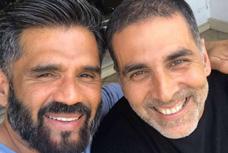
Mahesh Enjeti: AKSHAY: Ready for a face off?
SUNIEL: You Cage, I Travolta? Congrats, Mahesh! You win a movie ticket!
Some other good ones: Leyla Singh: Do u think ppl think we’re related?
Shikha Chandra: Subh set hai bro :)
I have a hypothesis that I wanted to run past you before I started posting this on my blog. When I was in school, I paid attention during biology class when the teachers were teaching us about genetics. I remember this time well - it was during the mango season, and the trees outside the classroom were full of beautiful ripe mangoes. As I was a studious young lady, I paid attention during class. From time to time, I allowed my attention to drift during maths class and I would gaze at the lovely mangoes and wished that Manoj from 3B would climb the tree and pick mangoes for me. In any case, I was lately browsing Bollywood news, and I noticed that not only Taimur Ali Khan has blue eyes, so does his cousin Inaaya. Now we all know that Saif and Soha and Kunal and Kereena all have brown eyes. How come their babies are blue eyed? Biology classes taught me that brown eyes are recessive - so how come all these generationally brown eyed people are having blue eyed babies? And so many Bollywood stars are having blue eyed kids - from Twinkle’s son Aarav, to Sanjay Dutt’s young daughter. What’s going on auntyji, are we all mutating into blue eyed people? Or do you think these people have had
ancestors who got up to no good? How is this possible? Do you think there is something in the food we are eating? Please advise post haste, I need to upload this to my blog on Tuesday please.
Arre budtehzeeb paapin! Do you not understand how genetics works? You really should not have been lusting after those mangoes otherwise you would have heard your teacher say that genetics are complicated, and that there are lots of factors that help present or suppress genes. I will give you this. All the Bollywood blue eyed babies are very very cute, and especially that Taimur. He is chooooo chweet, don’t you just want to pinch his chubby chubby cheeks and kiss him all over? Fortunately, us common folk don’t have access to the chhota nawab - so he is spared of our evil eyes. Anyway, back to your query. Genetics are complicated, and the expression of blue eyes or straight hair or tongue rolling ability have much more than just dominant recessive genes at play. If you are really keen to understand genetics, go read up on the subject, in the full knowledge that every day, new mysteries about genes are being unravelled. In the meantime, let Taimur and Inaaya be. Surely they are too cute and innocent to have paapins like you questioning their parentage, no?
Last week I left my Auntyji in charge of my three-year-old son while I ran an errand. When I came home, my lovely little Kunal was dressed in his cousin Sheena’s ghaghra choli with full face of makeup. He was singing and dancing while Sheena clapped her hands and shouted wah wah at him. Auntyji, I took one look at this tamasha, shrieked out a Hey Ram and fell to the zameen. I understand that was a bit melodramatic, but I was too shocked, and Mai aur kya karti, Ye paap mere samne ho raha tha! To maine Kunal ko grab kiya and left the house. I have not spoken to my aunt since, and I think she must hate me to do such a thing. I think she is trying to convert my son, and she must be listening to too many lefties and thinks it’s acceptable for that behuda harkat in my family. I am still bilkul pagal ki tarah traumatised. Do you think you could give my Mausi Pushpa a piece of your mind please? Can you do this for my bechara nadaan Kunal?
“An alligator can eat a quarter of its bodyweight in a single meal, equivalent to a human eating 89 bowls of rice,” a reader told me in an electronic conversation.
I was not impressed. Ever seen teenagers eat? Eighty-nine bowls is just the appetiser. This exchange was triggered by a March 3 news report that a snake in Florida was seen eating a deer larger than itself. The snake became a new Dining Hero for my son and me, replacing TV’s Miss Piggy, whose sensible eating plan is: “Never eat anything you cannot lift.”
So how did the snake eat something larger than it? Snakes temporarily dislocate their upper and lower jaws so that they can eat big things, including cows and buffaloes, said a herpetologist friend via email. (Humans have to do the same when eating those extra-tall burgers.)
A bird-lover in my office commented that some songbirds eat a meal of insects roughly every two seconds during their waking hours. That’s 30 meals a minute!
Definitely worth adding them to our Dining Heroes list.
Listening to this conversation was a colleague who was on a diet where you have six small meals a day. (I told her I totally loved the sound of that, except for the word “small”.)
The discussion became a competition. “Forget alligators. A growing hummingbird consumes twice its weight in food every single day,” the bird-lover said.
Impressive. In human terms, that would be equivalent to a teenaged boy eating a couple of sheep a day. Could teens really do that? I texted one to ask. “If you put them on a pizza, or cooked them as rogan josh, sure,” was his reply (after translation from teenspeak).
But hang on, you say, would that not be dangerous? I asked a doctor friend, and he said that physicians used to think it was impossible to eat yourself to death. But in 1985, medical journal The Lancet reported a case in which a 23-year-old woman consumed one pound (450 grams) of liver,
The T-Rex, a nine-patty cheeseburger created by an outlet of Canadian burger chain Wendy’s, has been safely extinct since 2013

two pounds of kidneys, an eight ounce steak, two eggs, a pound of cheese, two slices of bread, a pound of mushrooms, two pounds of carrots, a cauliflower, 10 peaches, four pears, two apples, four bananas, two pounds of plums, two pounds of grapes, and two glasses of milk. She was rushed to hospital where surgeons cut her open – but she died before they could remove her lunch.
It reminded me of a true story from this column in 2014. A woman ate so much to celebrate Lunar New Year that she exploded. A nutritionist at Beijing Friendship Hospital said the 58-yearold patient felt ill from overeating and demanded a lunchectomy. The electric
Arre, tum bhi ek budtehzeeb paapin ho. Tumhara hosh kaha hain? Apne deemag ka darwaza kholo, aur suno meri leftist leanings wali baatein Baachche log are innocent, nah? They probably saw an old rerun of choli ke peechche and they were just acting out what they saw on the screen. Isme boori baat kya hai? Or are you such a dayan that you think that all of these things are and now your poor Kunal will become something you can’t tolerate? Well, if so, you are a bigot, and there is no place in society for you. Kunal should be free to become whatever he wants to - unless it’s a serial killer in which case we will probably need to look no further than his bigoted mother to see why he turned out this way. Bachche log were just playing and having fun. You simply revealed yourself to be a close minded hate- lled bigot, who brought Ram into this. You really need to understand that we are who we are, and if Kunal chooses to wear clothes that he likes, then who are you to stand in his way. Duniya badal raha hai and you need to get with the times. And you owe your aunt an apology. She wasn’t doing anything other than allowing Kunal and Sheena to be happy. Un ke liye janaat intezar kar raha hai, while for you, the bhoots of narak are just waiting.
knife used by a surgeon provided a spark which met combustible gases from alcohol, causing a messy explosion in the operating theatre.
I don’t wish to be morbid or anything, but you have to admit, if you have to die, this is pretty cool way to go. You eat all your favourite foods, and before even your weighing scale can reproach you, BOOM, you’re done.
And someone else gets to clean up the mess. Now, please excuse me while I go dislocate my jaw.
Too much food for thought is never a bad thing… but what about too much food, asks NURY VITTACHI























within
days of completing the transaction. Vouchers are provided by a third party service provider Swych. Post successful transaction, you will receive
option of selecting
voucher of either
Myer. # A$15 Coles/Myer voucher offer is valid only for one transaction for active users of Remit2India on sending minimum A$2,500. Using coupon code LINK15 is mandatory and can be used only once.
will be sent within 14 working days of completing the transaction. Vouchers are provided by a third party service provider Swych. Post successful transaction, you will receive an option of selecting a single voucher of either Coles or Myer.
* Instant money transfer service is currently available for direct credits from any bank account in Australia into any account within the 23 listed banks in India up to a transaction limit of INR 1,00,000 per transfer. Instant transfer is available subject to certain limits on the amount sent and also clearing mandatory compliance verification processes.

^ Money on Referral (MOR) program: This is a referral program of Remit2India where you will receive INR 2,500 (equivalent to A$50 at an exchange rate of 50) for every friend that you refer and who transacts with Remit2India for the first time. It is mandatory for your friend to select Money on Referral and use your owner id while registering with Remit2India. You can refer as many friends you like.
Remit2India - Money Remittance to India at an affordable price. Remit2India is a secure online money transfer service for NRIs to send money to India from United States, United Kingdom, Australia, Singapore,Canada,
